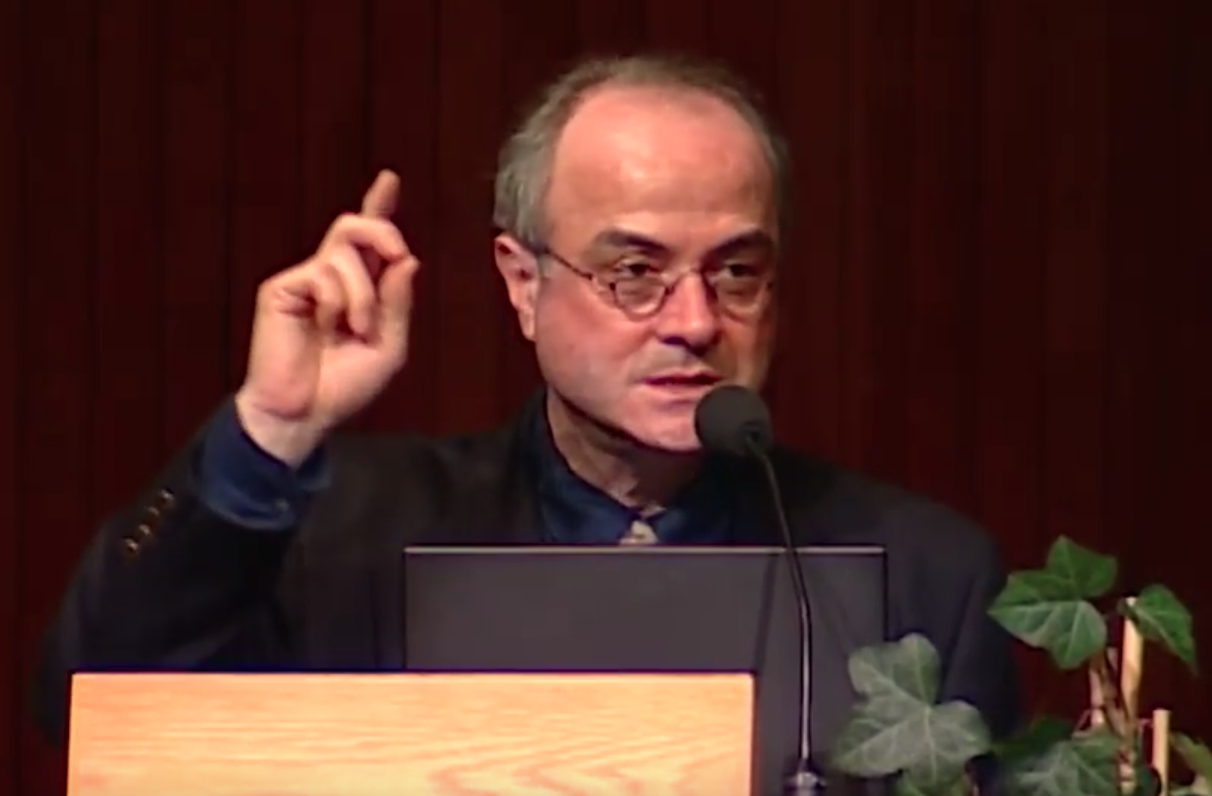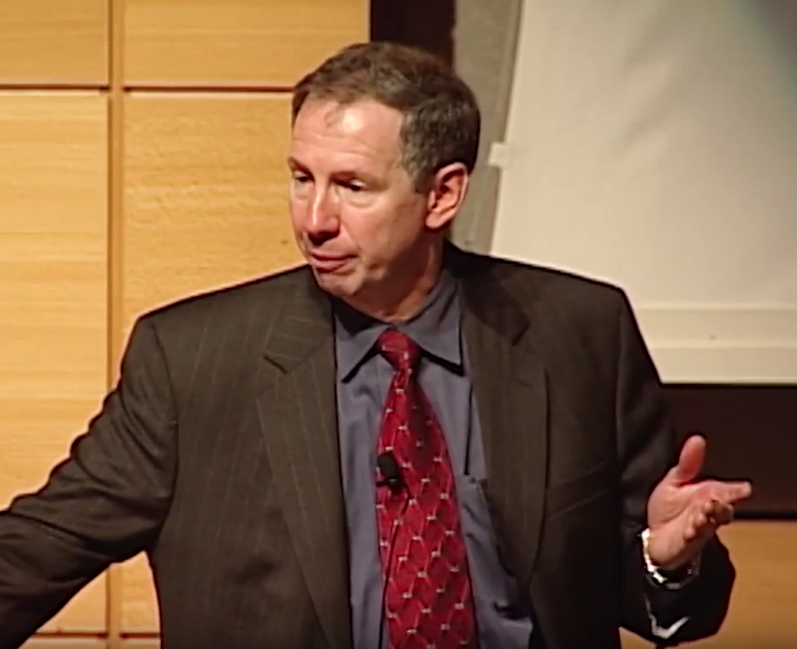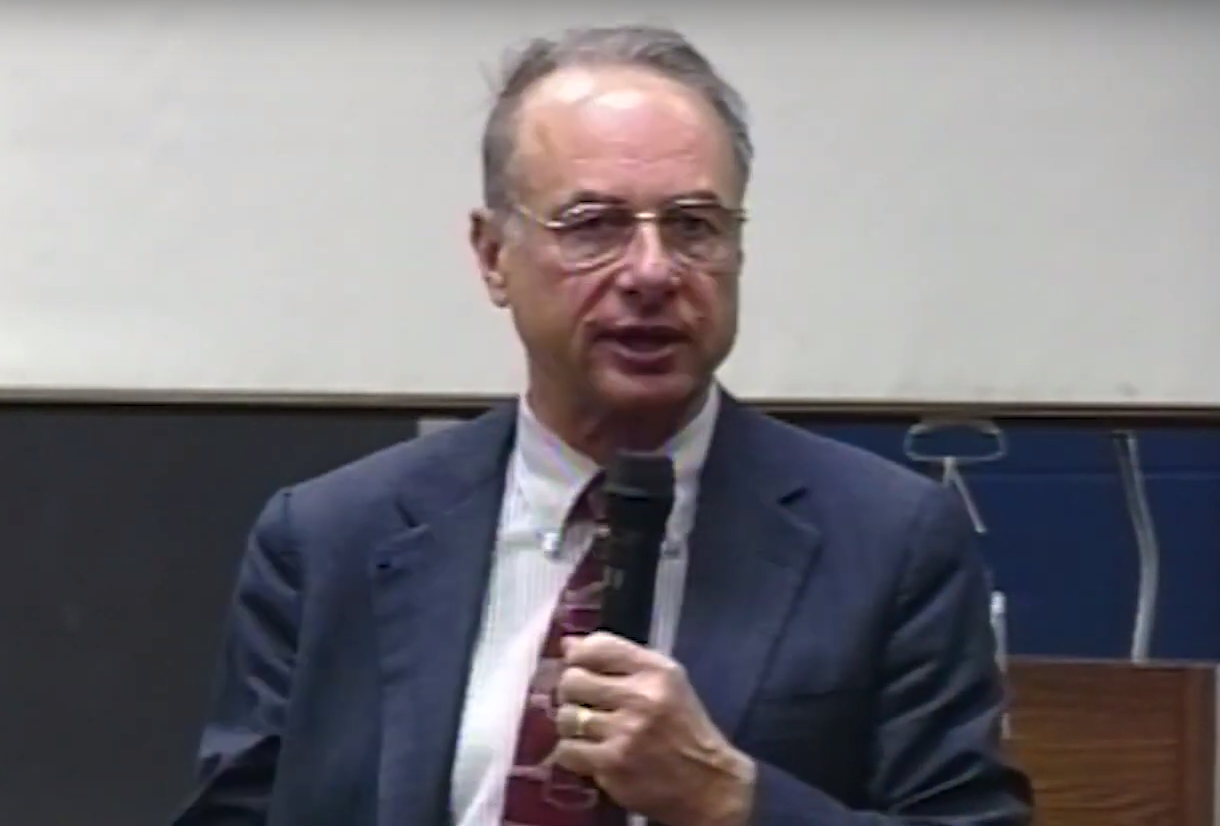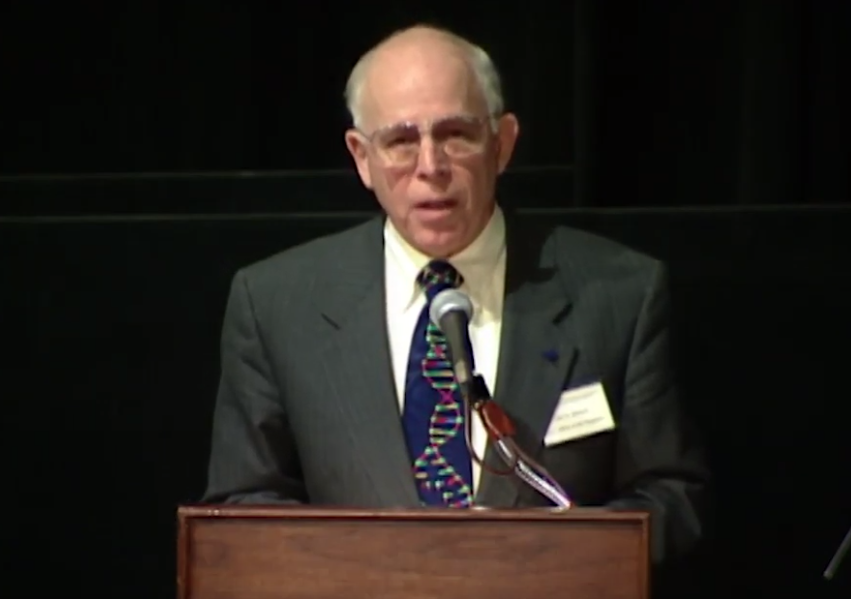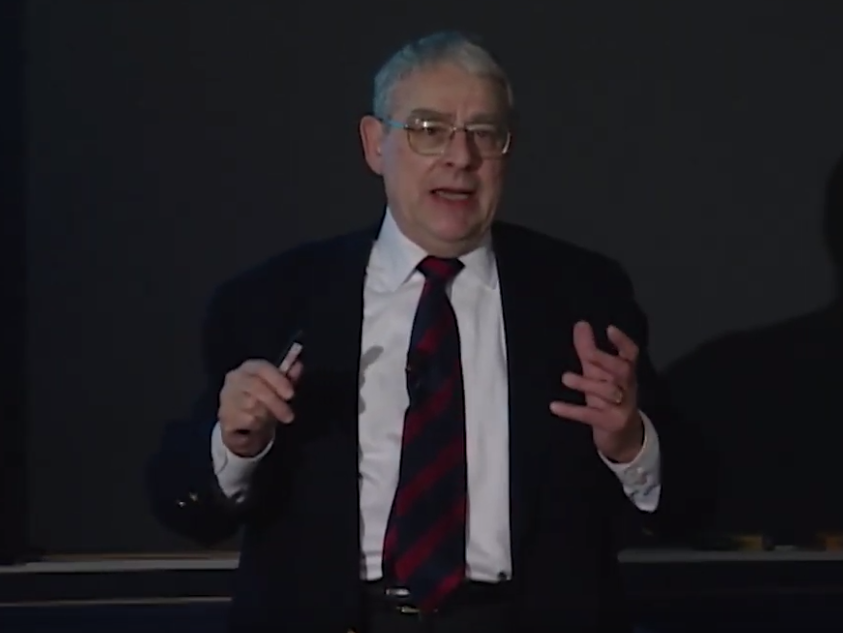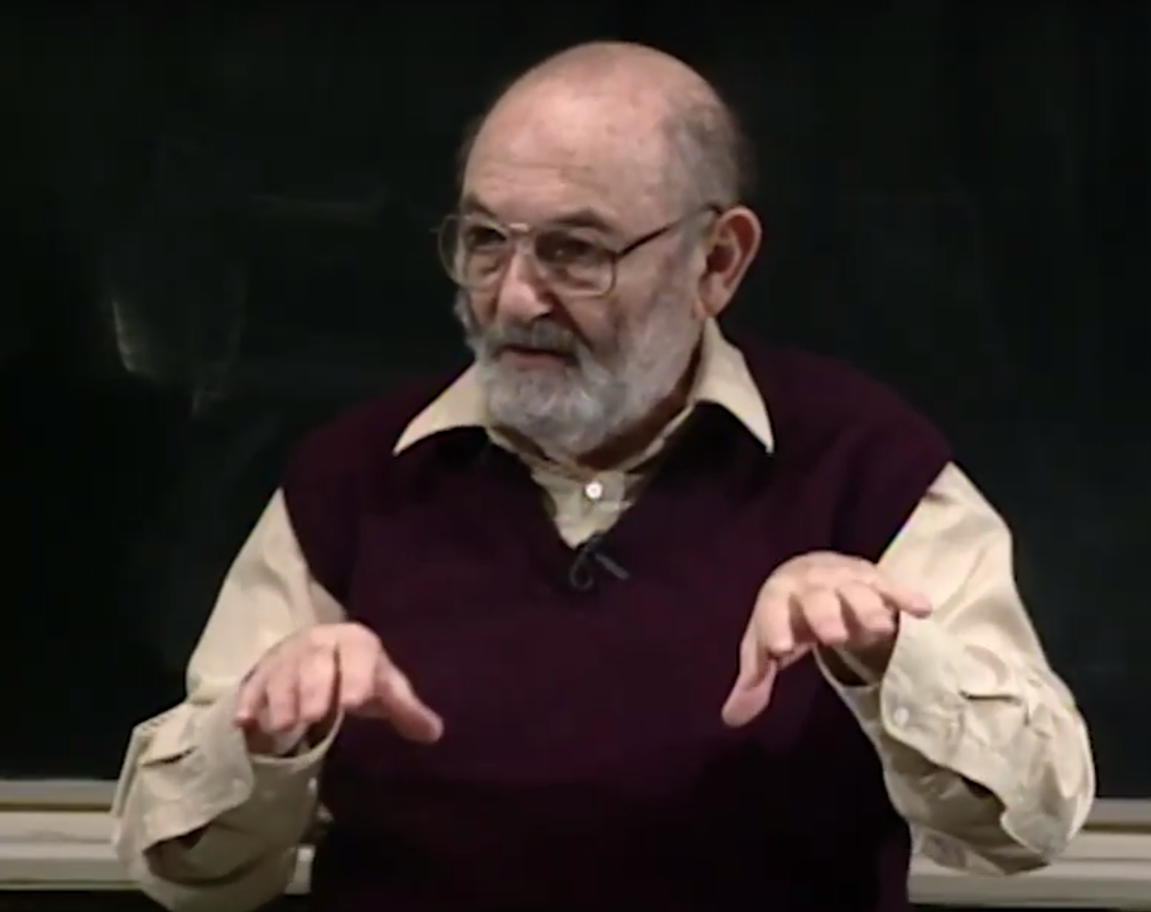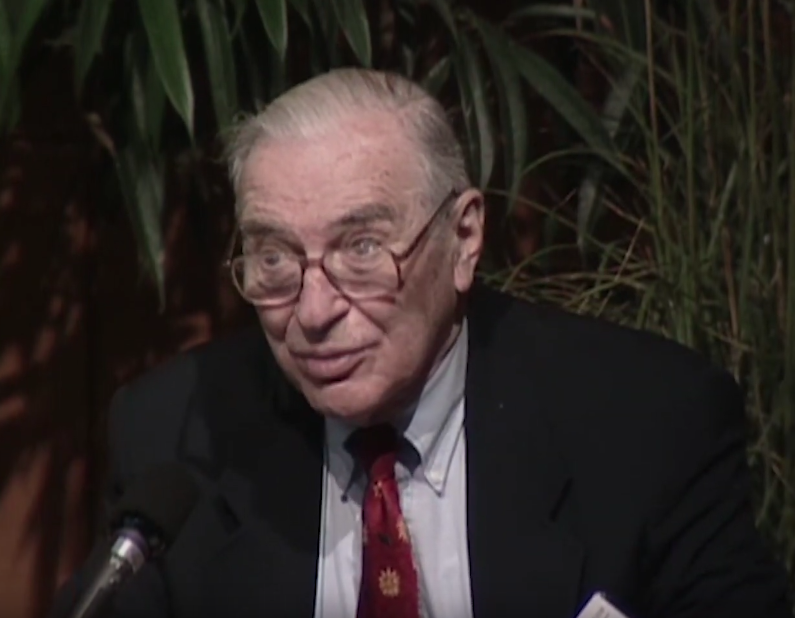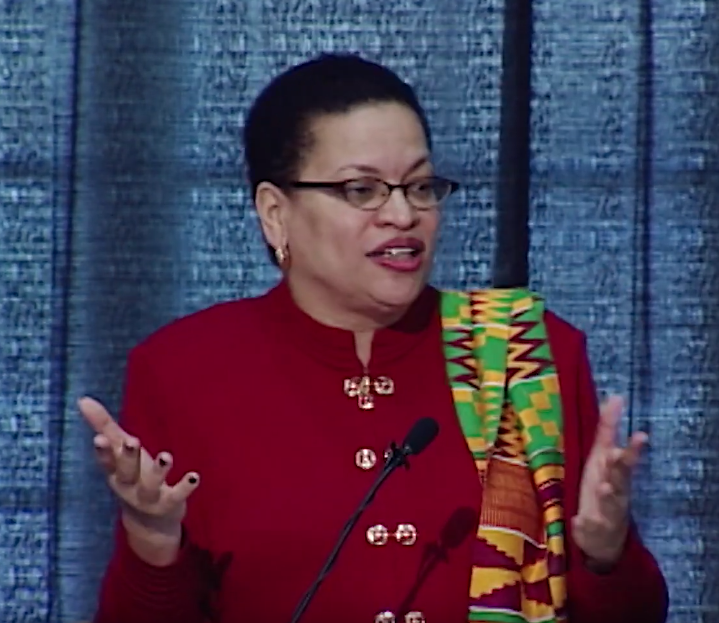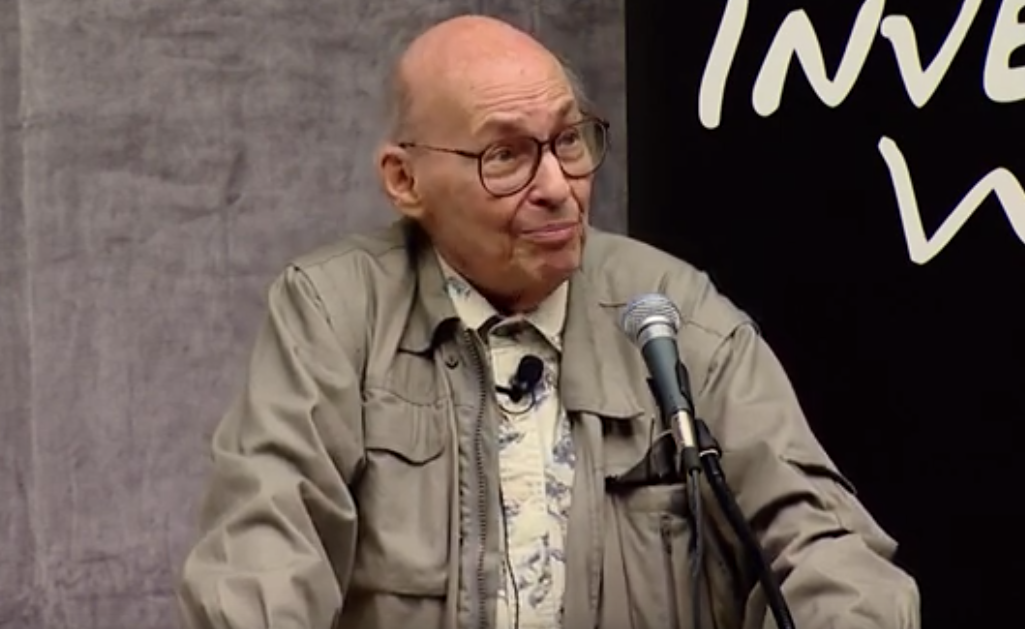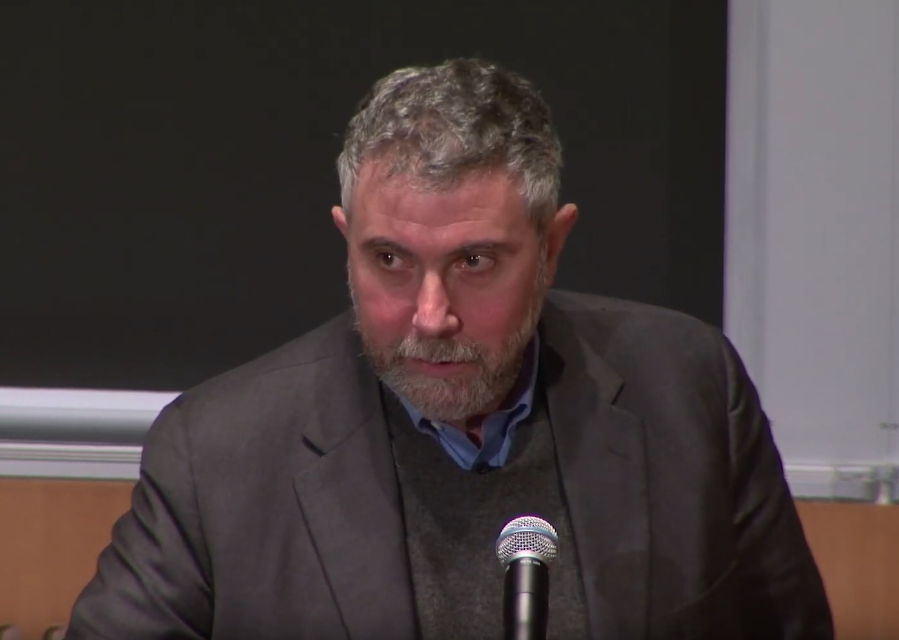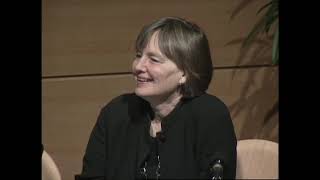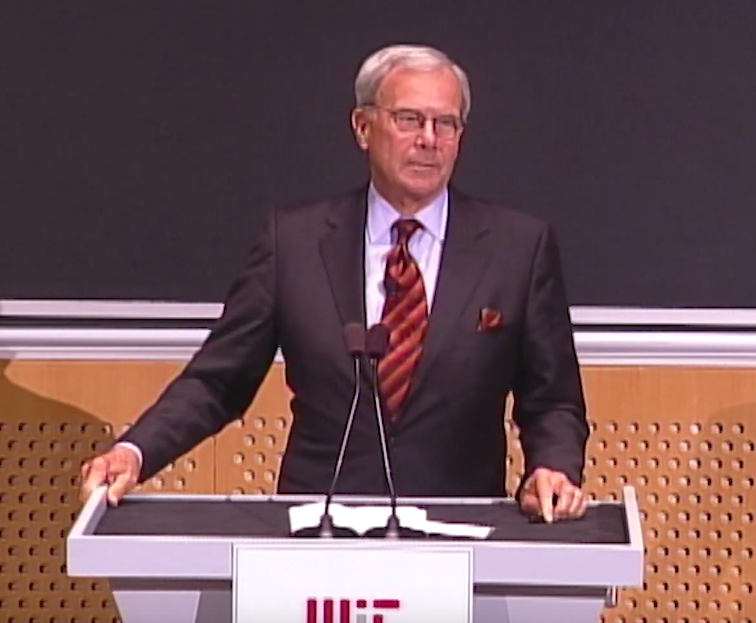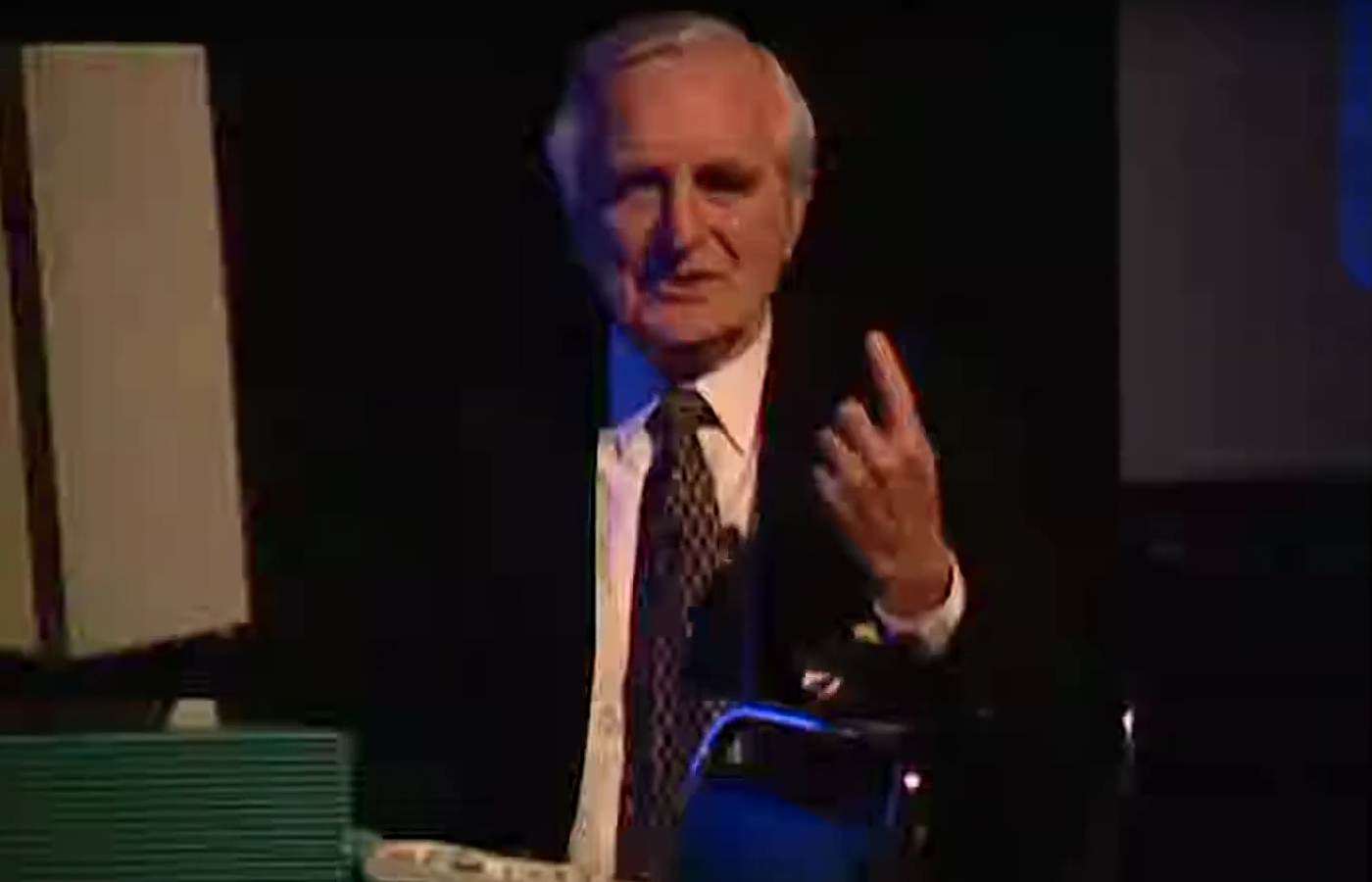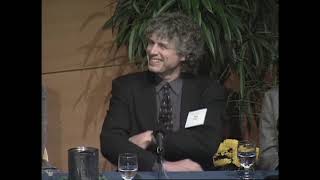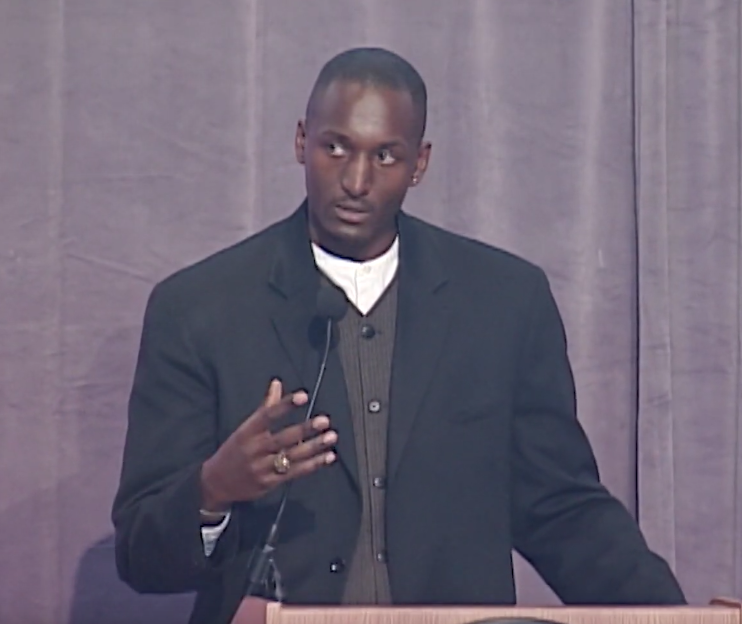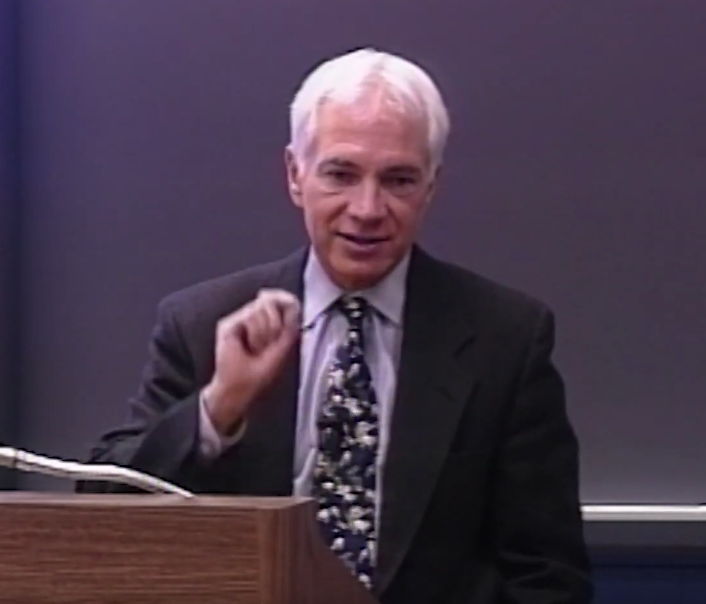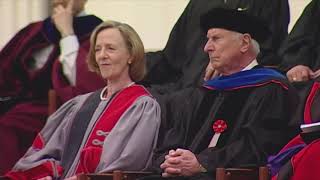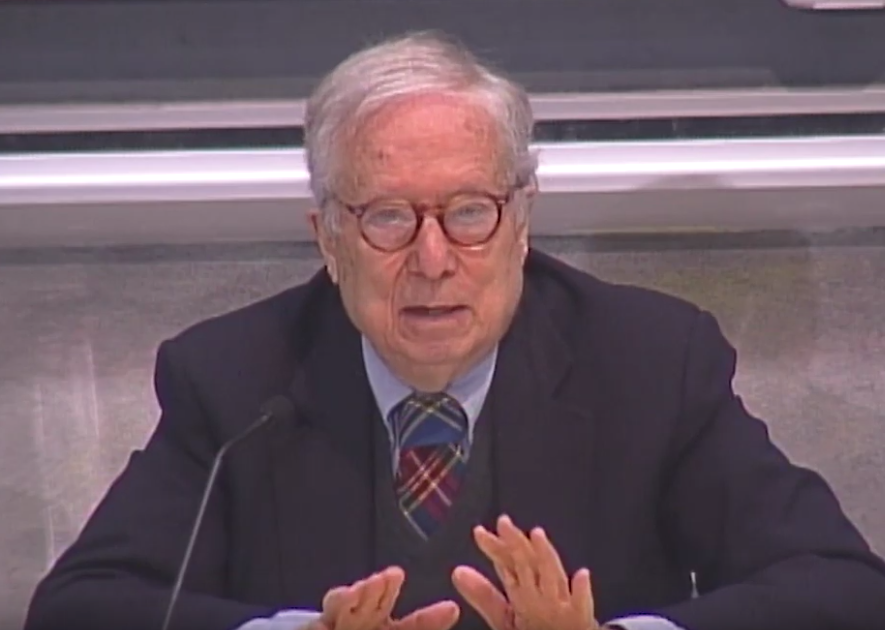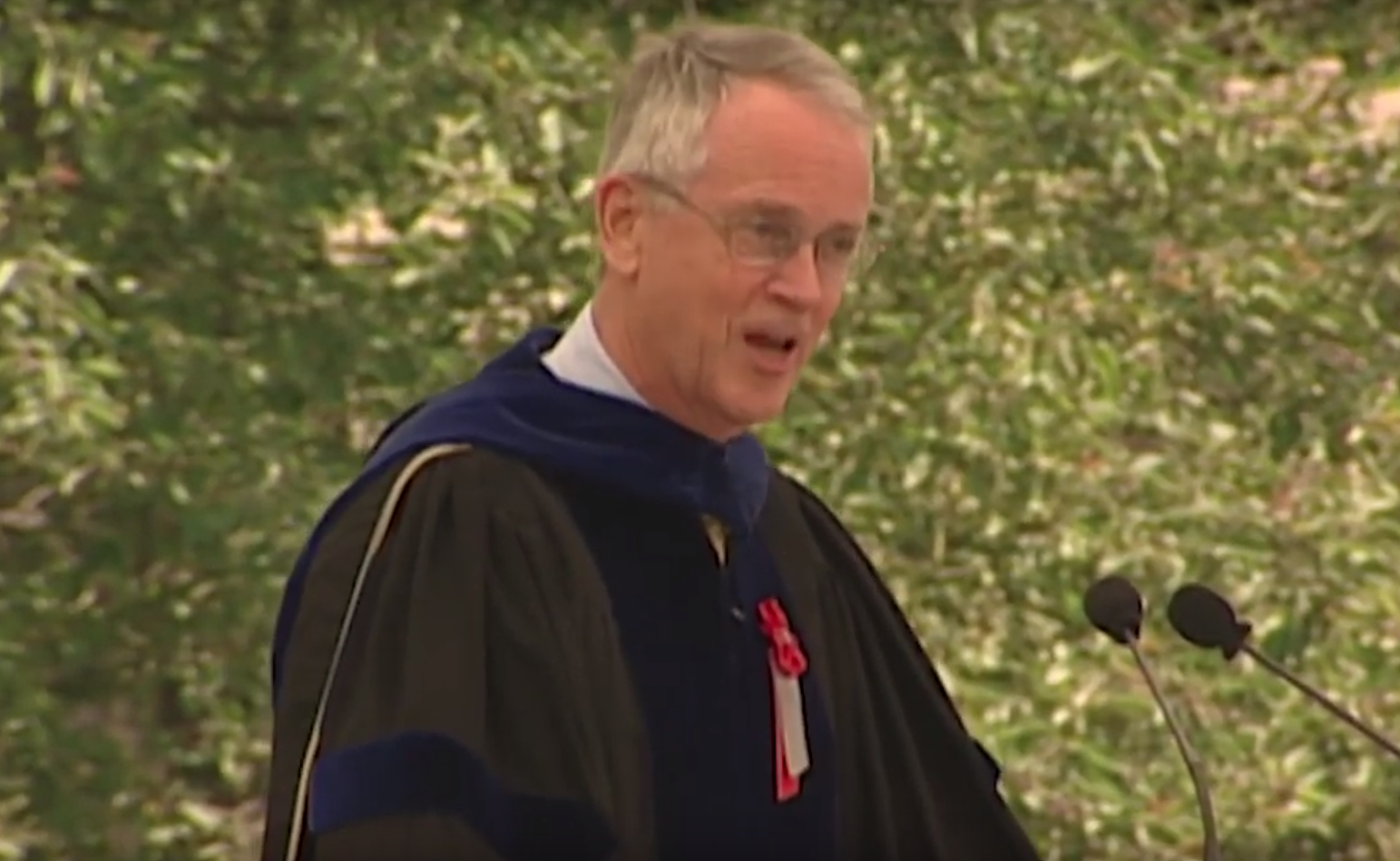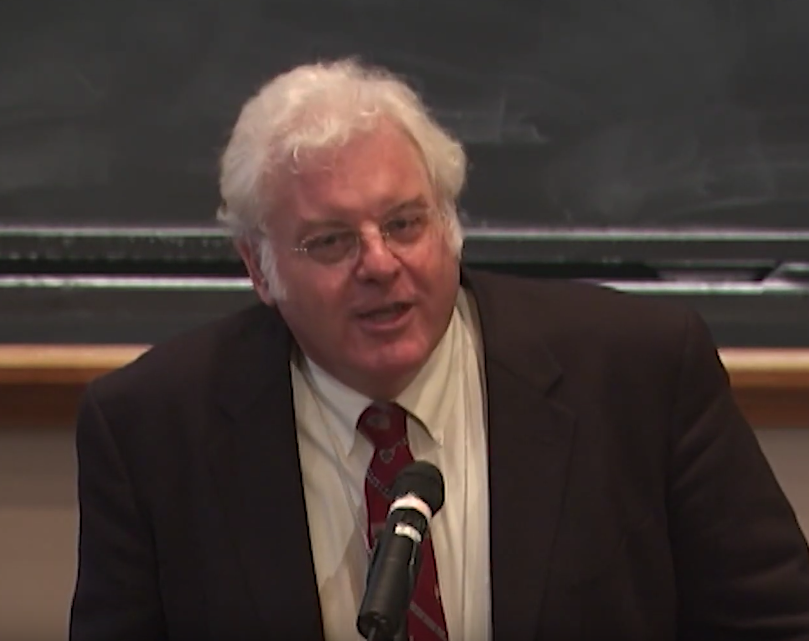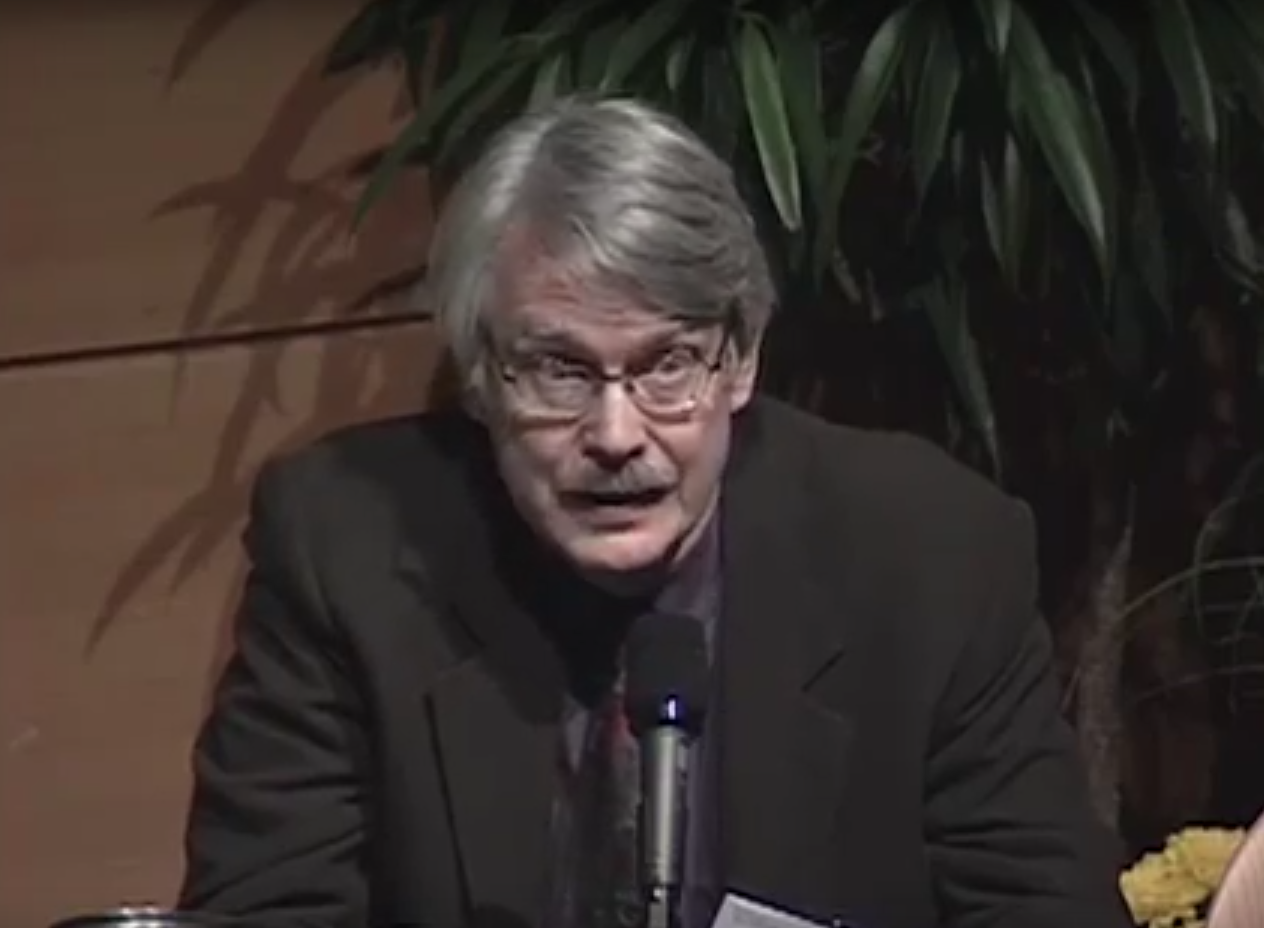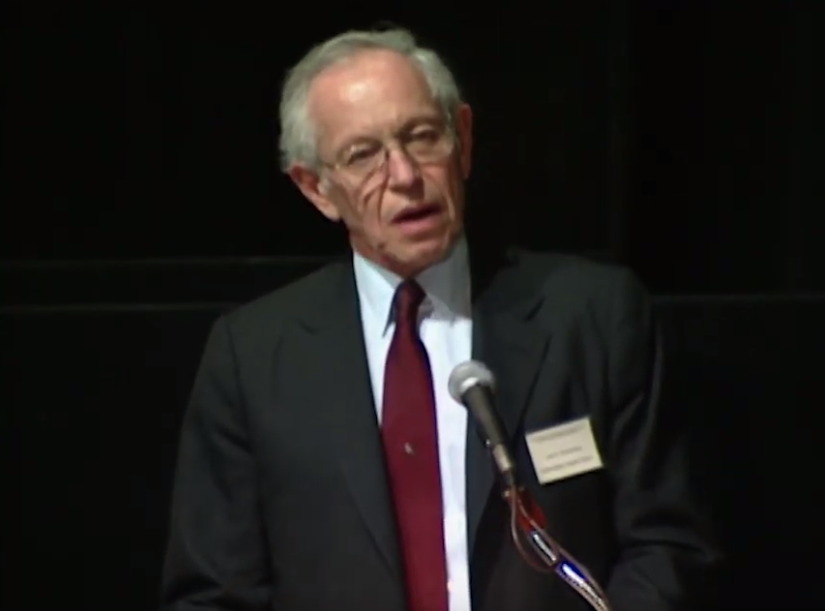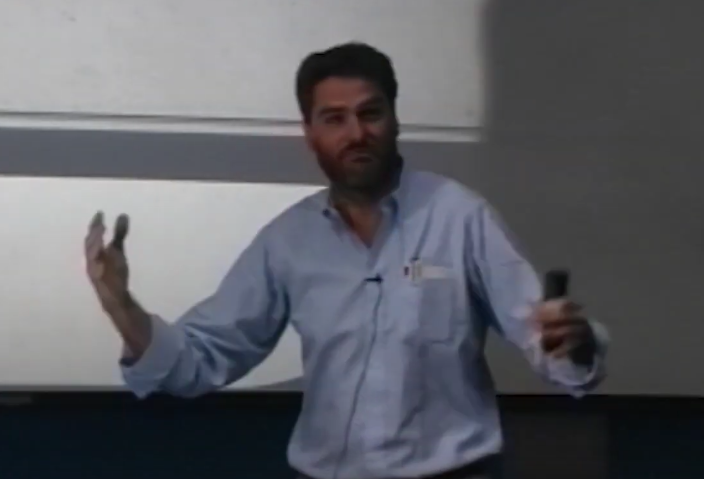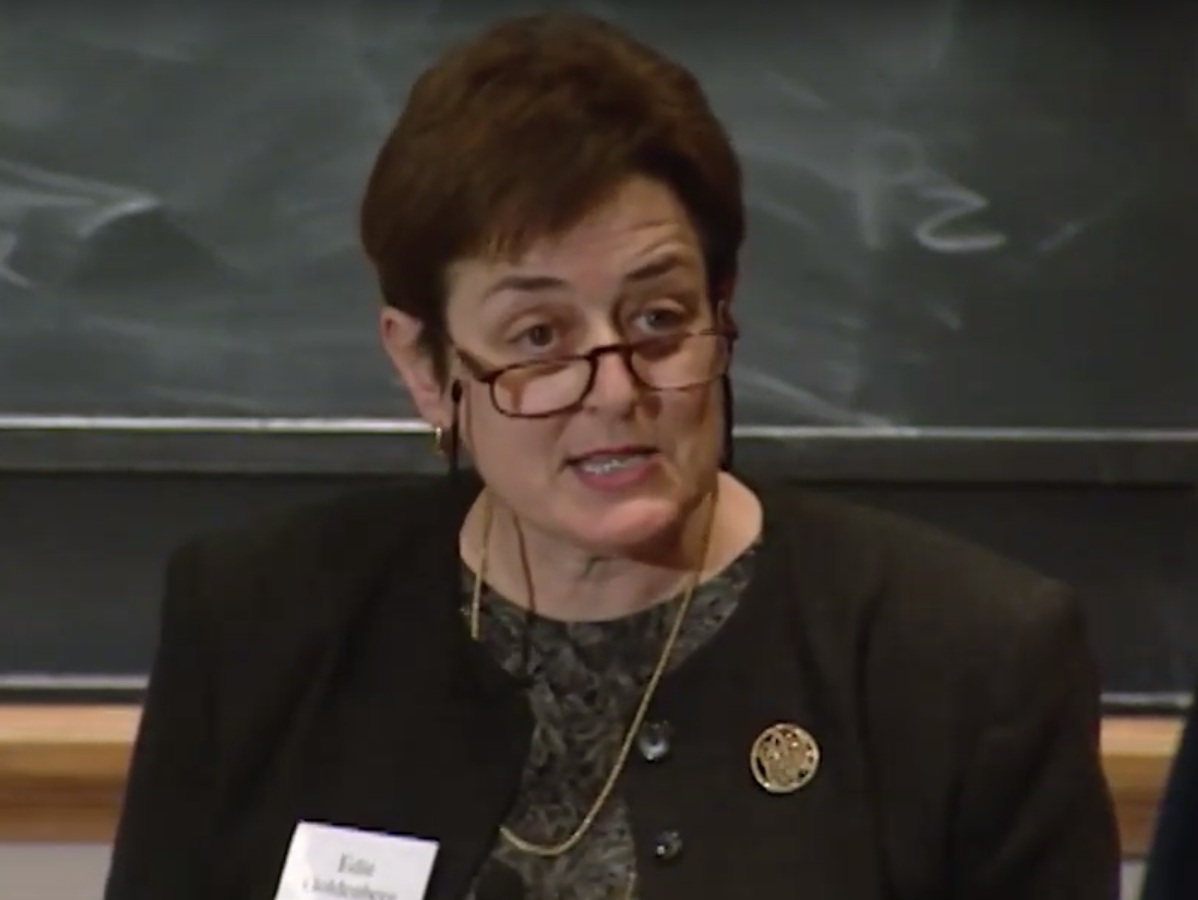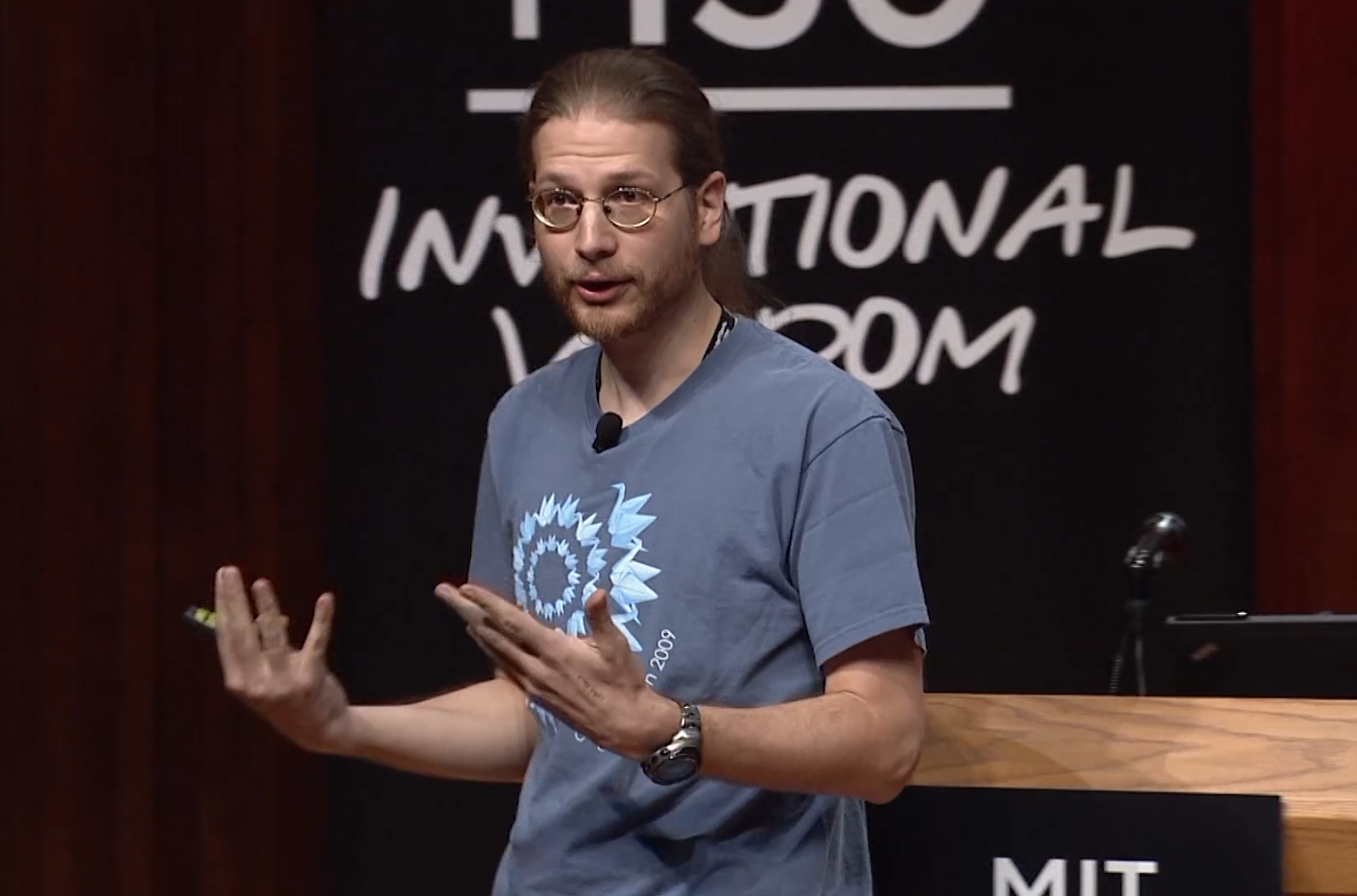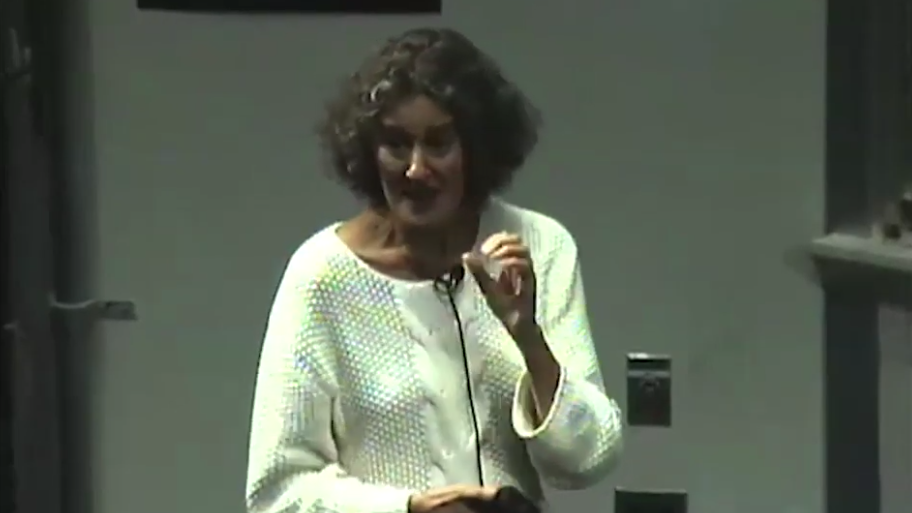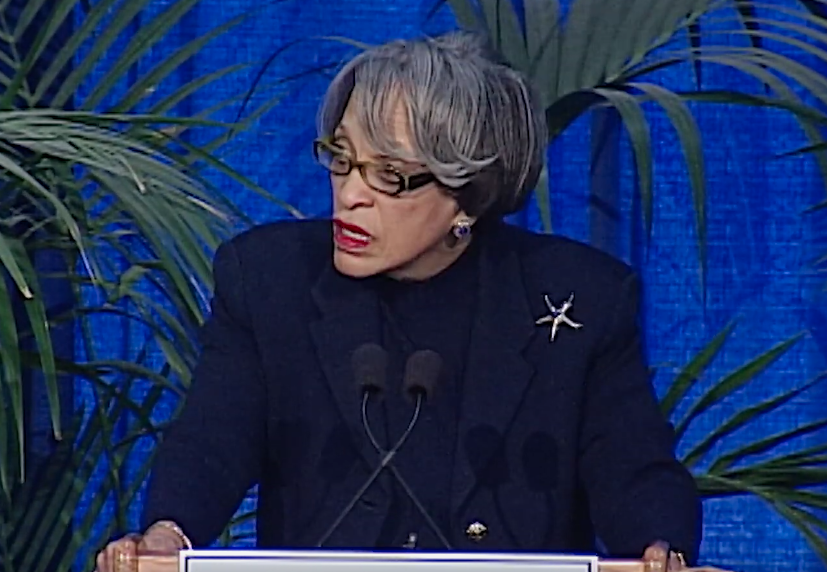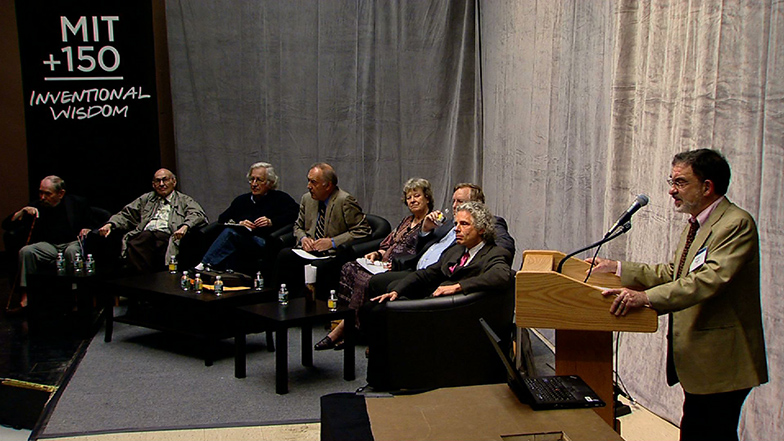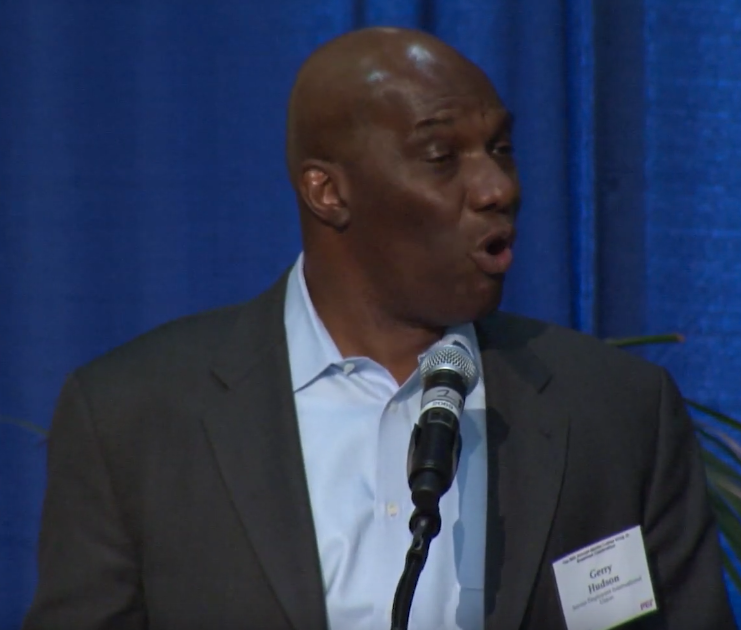MIT/Brown Vannevar Bush Symposium - Fifty Years After 'As We May Think’ (Part 1/5)
[MUSIC PLAYING]
PENFIELD: My name is Paul Penfield. I'm the MIT host of this symposium, and I'm pleased to welcome you all to MIT. I would say, first of all, I'd like to make sure that you all realize that the brains behind this whole outfit is this gentleman standing to your right here. That's Andy van Dam. And you'll have plenty of chance to hear him and see him in action, because he's going to be the MC for the whole affair.
And I want to make sure that you realize that if there is any success associated with this symposium, it's all due to him. And if there are any failures, it's probably because the local arrangements have not been done well, and that was my province.
OK, I will alert you to the fact the restrooms are located by the door where you came in. And just in case you didn't notice it-- this is always a question that people ask here-- I'd also like to tell you that the coffee breaks and the lunch are both held upstairs. And if you go back through the corridor that you used to get to this room, you will find a set of stairways which will lead you upstairs to where the coffee will be served during the coffee break, and the lunch will be served at noontime.
The reception this afternoon is in the lobby of a very appropriate building. It's the Bush Building at MIT. You will get directions on how to get there at the time, and there's also a little map in your packet that shows how to get there. And there will be a whole group of people that will go over en masse to there.
Now, at the banquet, the banquet will be held at the Hyatt, which is a hotel, which is down thataway. And you can also follow the whole group from the reception to get there. I don't think you'll have any problem. And it's all within walking distance.
Let me mention that this event is being transmitted three different ways, for those of you who are interested. The local audience probably is not, but those of you who are listening to my voice out there somewhere, out in Never Never Land, I'd mentioned that this is being broadcast on the MIT cable channel 9. It is also being broadcast by the multicast backbone system of the internet called Mbone. And Mbone is very good in supplying good audio and maybe some video.
In addition, the slides, as used by the various speakers, are available in real time on the worldwide web. And those of you who are listening right now can turn on a web browser and access the following URL. The URL is known as http://www-evat/bush/.
And somewhere I should have a foil which shows that, but unfortunately, the foil master disappeared on us. Oh, well let's get it up. Where's the foil itself? It's the third foil.
OK, those of you in TV land can now copy that down, and this should also be the foil which is shown on the worldwide web. Without saying anything more about this, I'd like to turn the proceedings over to Andy van Dam, who will give a little introduction, including something about the life of Bush himself, and will then introduce another speaker, Paul Kuhn. Andy?
DAM: Thanks very much, Paul. Good morning, ladies and gentlemen. Welcome to this wonderful celebration. I would like to start off by thanking the folks who made all this happen. And first and foremost, Lisa Manikowski, from Brown University and the Center for Graphics and Scientific Visualization. She has been this symposium. Can we have lights on her for a moment please?
She has eaten, drinken, and slept this symposium for the last few months, and she will also be behind the registration desk, and any logistics questions you may ask her about. Second of all, the gentleman who looks like you do not want to mess with him, over there, is Dr. Robert McDermott from Utah, AV specialist extraordinaire, as well as a computer graphics researcher. And he is our producer, and you do what he says. This is especially true for us speakers.
He and his sidekick, Jim Rose from Utah, have been working on this for a very long time, and mostly with their colleagues from the local institution, Larry Gallagher. Can we see you, Larry, or is he in the back room? I assume most of these people are hard at work making the conference happen. So we'll just give him a round after I finish.
Scott Dynes, who was pressed into service relatively recently to learn all about Mbone, and is now a certified Mbone guru. And Ed Moriarty, who has been doing yeoman's service on all aspects of systems, computers, and AV, local folks who've done a heroic service. Let's have a hand for them.
David Clobhock Brown has been helping out with producing all aspects of the symposium slides, various details of AV, and organizing a group of student and staff volunteers from both Brown and MIT. Thank you very much, folks.
Second category of people without whom we wouldn't be here are the sponsors who have contributed money to make this happen. National Science Foundation, Apple, Microsoft, the center, the individual home institutions, and two companies who kindly lent us the gear that we will be using today. Thanks.
Now, what I'd like to do to set the stage a little bit is to tell you how this celebration came about. And I want to give all appropriate credit to the folks who actually had the idea-- to wit, Greg Lloyd, Steve DeRose, and Chris Newsom, former students of mine well indoctrinated in hypertext and hypermedia systems, in the case of Greg, going back to the '60s.
And these folks are now employees of electronic book technologies. They formed a reading club, and read all through the literature and came to my office one Saturday and said, look, do you realize it's 50 years ago that As We May Think came out. We should do something. We cannot leave this the occasion go unmarked. And I said, you're right. That's a very good idea.
So then they said, all right, fine. Why don't you execute this wonderful idea? And so they can get the credit for having had it, and the rest of us were left to implement. Now, my concept of what we ought to do to mark this is not to have a media circus, but instead to have a small research symposium which, in German academic life last century, was called a fest shrift, fest in the sense of festivity, and shrift in the sense of something written down. Well, different media today, but you get the idea.
Essentially, you honor an outstanding researcher by having a research symposium in his or her honor, populated by the best folks in that field and a lot of former students, typically. So my concept for this was, let's put on the only thing we can do, a posthumous fest shrift, and honor him by having pioneering researchers speak many of whom have been influenced by, as we may think. We found great enthusiasm on the part of Dr. Paul Penfield, and he threw himself into this project with heart and soul and many late night hours, particularly to work up this companion piece of software that he modestly told us about in just a moment.
I'm proud to say that all of the speakers I invited accepted. I think that's a pretty good testament to the magic of the Bush name and the contribution. Now this event-- I want to give you some caveats about what this event is and is not. It is specifically focused on highlighting as we may think. Not the many other hugely important aspects of Bush's amazing career and his great impact on our society. To do justice to Bush, the man and all his contributions, would require a set of specialized symposia, some technical, some social political and economic and philosophical, and that work remains to be done by another group.
Now this symposium, even in its narrow focus, is in no way meant to be either comprehensive or representative. There isn't time or room. I picked a handful of true computer pioneers who have helped to define our field, and they will speak to various aspects of the, as we may think, memex vocoder vision. And I preferred longer, more thoughtful, in-depth talks to a larger number of shorter talks. Matter of taste.
What I want to do now, having told you a little bit about the genesis of this, is to do a very cursory job reintroducing you to Bush the man and his manifold contributions. What I'd like to do before the chronology is to roll a couple of minutes of videotape, which Paul has lent us. Can I black that, Robert? Thank you.
[VIDEO PLAYBACK]
- Dr. Vannevar Bush is one of America's more important citizens. Now in his 66th year, this son of a universalist minister has served the government for various periods over a period of about 40 years. And the last four presidents have called him Van.
Dr. Bush has been called the dean of American Scientists, one of the great mathematicians, electrical engineers, and research administrators of our time. During World War II, he was the guiding spirit and the driving force of America's achievements in the physical and medical sciences. He was the research boss of the atomic scientists, the first civilian scientist to sit with our highest war council.
Dr. Bush served many years as vice president of MIT, the Massachusetts Institute of Technology. And recently, he retired as president of the Carnegie Institution of Washington. Today, Dr. And Mrs. Bush live in this brand new house that they recently finished building. It's on a wooded hilltop, a half hour drive west of Boston in Belmont, Massachusetts.
Good evening Dr. Bush.
- Why, good evening, Ed.
- How are you tonight?
- Very well indeed, thank you.
- Well, sir, I've known you a number of years, and last week I managed to mispronounce Vannevar, and I apologize.
- Well, you've got plenty of company there, Ed. Most everyone mispronounces it. I think the record is held by one postmaster who managed to pronounce it four different ways in the course of one evening.
- Dr. Bush, you built electric brains and atomic bombs. How does that compare with the experience of building a new house?
- Well, building a house is a much more pleasant experience.
[END PLAYBACK]
DAM: So now you know that we've all been mispronouncing it all these years. I'm told it's originally a Dutch name, but being Dutch, I don't necessarily buy that. OK, slide again, please. There is no way to do justice in just a few slides to this truly remarkable career. So I just took a few of the highlights. I may have missed some other highlights.
You'll notice his life in academe was all in the Northeast. He spent a huge part of it at MIT and started working in the '20s already on what we now think of as an analog computer, the differential analyzer, many, many versions of it, including into World War II, the Rockefeller differential analyzer, which was partially electronic and partially mechanical, and was a huge room full of numerical calculation equipment.
He was appointed vice president of MIT and the first dean of the School of Engineering, as Paul Penfield reminded me, patented the differential analyzer, and then started working on the device that concerns us most here today, the microfilm based rapid selector, which was an information storage, and especially retrieval mechanism. He then went to Washington.
He had many positions in Washington, and was probably the most, single most influential scientist and engineer during the war years, throwing himself into the war effort on a number of fronts. What is particularly important to us is this appointment to the office of scientific research and development, and the fact that he was President Roosevelt's science advisor. And these various appointments made him a central figure in the development of nuclear fission, and indeed, he was the one who kicked off the Manhattan Project.
In '45, as we know, As We May Think appeared. It was based on more than a decade of cogitation in this area. So he was basically summarizing what he had been thinking and working on for a very long time. Then, very important to our profession as a whole, indeed, to science as a whole, President Roosevelt asked Dr. Bush to think about what we could learn from World War II and to see how we could apply the enormous progress in science and engineering to the civilian sector, not just to war.
He wrote Science, the Endless Frontier, which led effectively via one of its recommendations to the formation of the Science Foundation. This is what the report looks like. We have a copy of it here if any of you would like to browse. And this is one of the wonderful quotes from there, still as relevant today as when he wrote it.
"The pioneer spirit is still vigorous within this nation. Science offers a largely unexplored hinterland for the pioneer who has the tools to--" I can't quite read it from here. "--for this task. The rewards of such exploration, both for the nation and the individual, are great. Scientific progress is one essential key in our security as a nation to our better health, to more jobs, to a better standard of living, and to our cultural progress."
Powerful words. He was appointed chairman of yet another national military establishment board. And it's important to remember that he was a civilian, and it was most unusual for a civilian to hold all these high positions influencing the course of the military directly. Another offshoot of his interest in microfilm and recording and distributing things photographically is that he founded and became chairman of the Graphics Arts Research, which developed the photon photo typesetter.
Then he became a member of the National Science Foundation Advisory Committee, chairman of the MIT Corporation, and honorary chairman of the MIT Corporation for many years. Here are some of his selected publications. And it's interesting to note how widely he wrote. He didn't just write about science or science policy. He also wrote about multiple other things, somewhat related, in books like this, a collection of essays, where, for example, he has multiple chapters devoted to his musings on the art and science of management.
"All my life, which has now lasted something under 100 years, I've observed managers in action: in government and universities and in industry, and I have puzzled over what made them tick. I'm far from the end of the puzzle, for no man can ever fully understand another, even a close friend. But can we probe a bit toward the essence of the good, the great, managers' success? The world is so short on good managers that it is certainly worth a try." And then he has many interesting observations about what makes for a good manager.
The list of honors is phenomenal, and we decided to stick to just one page. Here they are. I'm not going to read them to you. You notice that they include both the order of the British Empire and presidential medals presented by presidents. I can't think of anyone more honored for a multitude of activities, engineering, science, and policy making, than Vannevar Bush. And another partial reflection of how he was appreciated-- a list of his honorary degrees.
The thing that I want to do next, having said just the briefest outline of his life and times, is to give my own spin on memex and Bush's thinking in context. So I'm gonna talk for a few minutes about historical antecedents.
Although we might like to think that we're only now entering, or well into the information age, the acquisition and management of information has, of course, been central to human society since prehistoric times. Language is an invention. It is a technology for organizing and transmitting information. Writing, in particular, transformed the ability of societies to record and transmit culture and information.
More specifically, the phonetic alphabet was an immense improvement on its syllabic and ideographic predecessors. Other major achievements, which we tend to take for granted, but we shouldn't, because they are so hugely important in our successful ability to deal with information, the invention of the page, of punctuation, of spacing between words, of capitalization, tables of content, indices, alphabetic sorting, and so on. These were inventions, and they took time to take root and they've made a qualitative and quantitative difference in our productivity.
Now, hypertext, as a very particular style of writing, non-sequential writing as Ted defined it, deals with things like marginalia and cross references, and see also's. Now, textual techniques make an appearance very early on in the history of writing, and have evolved to be a major feature of our literacy in the largest sense. I just want to illustrate with a couple of things that I find fascinating.
This is a 16th century King James epistle of Apostle Paul to the Romans. And you will see that there is not just the main text, but little superscripts and lots of marginalia, which itself has additional cross references. And this helped you understand the Bible, the writings in their cultural, historical, and religious contests.
Now, this 16th century manuscript hardly started this technology, and it wasn't obvious to the average reader on exactly how it was to be used as a tool. So the printer felt it necessary to instruct the reader on how to deal with this, and wrote what I consider to be one of the first user's manuals.
It says, "Diligent Reader, Dear Christian Reader, to the intent thou mightest better enjoy the benefit of these--" I can't read it from here. I apologize. "These notes are expositions upon the New Testament. I thought it not amiss to declare unto thee the rules of the same." In other words, he lays out the typographic conventions and exactly how you are to wend your way through this.
Because not everybody who picked up this manuscript was familiar with other things like it, like the Talmud, which for many centuries had made it a point of having annotation be the point of the discourse. So the center is the primary text, and then we have generations of commentary, and commentary upon commentary, with all their cross references scattered typographically about the page. And that, too, is a convention that has to be learned.
Well, the Talmud didn't invent marginalia, either. We can go much further back. This manuscript from poems by Bacchylides, I'm mispronouncing, no doubt, is a papyrus scroll that dates roughly from 3, the third century A.D., but the poet actually wrote it 3 centuries B.D. And fortunately, the written version of this, which we cannot tell how faithful it was to the original, was found, along with other scrolls, in the sands of the Egyptian desert and were preserved for our edification and pleasure.
So here's an example of that. You will notice in the second column-- I forgot to bring the laser pointer-- but you can see in the second column there are two kinds of things sticking off slightly to the left, a marginal note, and then there is some kind of little glyph at the bottom that is probably some kind of coded reference.
So thank you. The man who is never unprepared. Right there, and right there. Thanks.
Well, not surprisingly, inventors, at least as far back as the Renaissance, imagined mechanical devices to support hypertextual readings. I want to show you one absolutely stunning wood cut from an engineer from the 16th century, Ramelli, who invented, effectively, a rotating bookcase in which you could have pages opened and cross references to other pages. And then just by turning a wheel, which was a carved, levered piece of machinery, get yourself to the appropriate place.
This was imitated by Chinese, and I have a lovely drawing of a Chinese temple that I can show you later which shows one of these machines in it in symbolic form. And then we actually have some ruins that people photographed from a temple from I think 6th century A.D., where a device like this was apparently built. So mechanical aids have been around for a long time.
More recently, researchers such as Michael Buckland, who studied the history of information technology, and W. Boyd Raymond, have been recovering for our attention neglected 19th and 20th century thinkers. Two I'll mention today-- Paul Otlet, a Belgian who lived from 1868 to 1944, and Emmanuel Goldberg, a Russian from 1881 to 1970, both of whom created information management systems in the early 20th century.
Otlet, for instance, implemented a hypertext like system with analog means, and imagined multimedia document management systems that would work with linked microfilm and telecommunications based on a variant of the Dewy Decimal called the universal decimal classification. And probably the first book on information science was [FRENCH], written in 1934.
Goldberg, who became the first managing director of Zeiss Ikon in Germany, demonstrated and later patented a prototype of a microfilm selector, much like memex, using a photoelectric cell, the first functioning electronic document retrieval system in 1932. His patent was, in fact, prior art for Bush's attempt to patent the rapid selector. He was unfortunately driven out by the Nazis, first went to Paris, then to Israel, where he died.
These ingenious systems were in some respects similar to Bush's, in some respects different. I really hope you will get a chance to look at the work of these earlier thinkers and thank folks who brought these citations to my attention. They're absolutely fascinating. But our perspective today is not with Bush's predecessors, but with Bush and his followers. And for introducing you to that theme of our conference, I'd like introduce you to my friend and colleague, Paul Kahn, who is going to tell us a little bit about Bush and the memex.
Paul is one of the two official, in quotes, "memex historians," by virtue of having written the book that you all know about, memex to hypertext in Academic Press 1991, From Memex to Hypertext by Nyce and Kahn. He got a BS in English from Kenyon. He was a director at the Institute for Research and Information Science at Brown University that I helped start in the early '80s. And after Iris folded, he became president of dynamic diagrams, where he still is.
Under his direction this summer, Ian Edelman did a memex visualization using Macromedia Director, and that is one of the things that Paul will show us. Paul, would you come on stage, please?
KAHN: Can I get the slides? What I'm going to do is go over some visual material. Andy has shown you a timeline with some of the names and some of the dates. I'm going to show you some pictures that correspond to a number of the machines that he's already discussed.
This is Vannevar Bush, 1912. He's a graduate student at Tufts University in Medford Massachusetts. And this is his first invention. This machine was called the profile tracer. It was a machine for doing surveying of land. Next slide, please.
Oh, I got a-- I make the next slide. Sorry. This machine would actually draw out the profile of the land that you ran it across. And the reason that it did that was a mechanism that involved a wheel integrator that would actually plot on paper. And it was this basic technique or technology that became the starting point for many of the analog computers that Bush then later developed at MIT with his graduate students.
The first really successful one was called the product intergraph. This is from 1925, and was developed at MIT between '25 and '28. This machine, which was both electrical and mechanical-- there's an electric motor by his hand there-- was capable of solving second order differential equations, and was awarded a number of engineering prizes. The mechanism behind this-- and it could get quite large when you wanted to solve fairly large second order differential equations. That's Van in the front of the line there.
The mechanism behind this became the basis for what was then developed around 1928 through the mid '30s, the differential analyzer, which was a little bit larger. And the differential analyzer was capable of running very complex differential equations. And people literally came from all over the world to MIT to solve their differential equations on this machine. And there were a number of machines built in Europe imitating this machine.
To solve an equation, you actually had to set up all of the wheels and the rods to model the equation, and then you ran it. And it would solve the equation by plotting it out in curves on these readouts. This is Sam Caldwell in the foreground and Van Bush behind him, looking at a family of curves. This photo is from around 1932.
So this technology was very promising and won many awards and funding from a number of agencies. And this was really the main line of research that Bush was known for before he went to Washington and became a major public figure. The line of research here at MIT culminated in the largest of these machines, the Rockefeller differential analyzer. That's what you see in this photograph.
And just to get a sense of scope here, this machine weighed about 100 tons, had 2000 vacuum tubes, a few thousand relays, and 150 motors. This machine was built in '42 and was used for calculating ballistics tables during the war. It was made public in '45, and by the time it was shut down in 1950, it was the last of the analog machines. It was quite clear by the late '40s that this was just not a particularly fruitful line of research once digital computers began to be developed in the mid and late '40s.
But what really concerns us is another line of research that was going on in parallel with this. Around 1937, here at MIT in one of the labs, Bush was supervising a project for building a microfilm rapid selector. And unfortunately, there are no photographs or actual drawings of this machine. But this schematic, which was put together by Tom Bag at one of the National Research institutes, is the best thing we've got.
And what's going on here is that you had a roll of 35 millimeter film-- figure out what to press. Here we go. There was a roll of 35 millimeter film, and that film on each frame of the standard movie film had basically a double frame. One frame was a piece of microfilm with a picture of a page, and the rest of that film was a mask of dots. That film could be run fairly rapidly through a transport mechanism. There were about 120,000 frames on the roll and you could run that roll through the machine in about two minutes.
There was a set of photo relays over here that was running light through the mask, and the strobe, which had been developed by Dr. Edgerton here at MIT was being used to fire off a second recording camera when the mask actually matched the dot pattern on the film. And so it would rerecord individual frames on a second roll of film. You could develop a mask that matched the particular piece of information you wanted to retrieve off the film, it would run through the entire film, rerecord only those frames that contained the information you were looking for, and then you had a second microfilm that contained those select pages.
This is the technology that was being developed in Bush's lab. And this, as far as we can tell, is the technology that was behind the article that he was writing at the time, the first manuscript that we found here at the MIT archives. Jim Nyce and I, when we were working on this, of what became, as we may think, was entitled Mechanization in the Record. And it dates from around 1938 before Bush left MIT and went to Washington.
This idea of having microfilm rapid selectors continued to be developed in the '50s and the '60s. This is a microfilm rapid selector film from one that was done at the ERA in Washington. And this was done under CIA sponsorship at Yale University in the 1960s. As you see, the dot patterns got more complex. The problem with these machines was that they didn't work.
They were really a very nice idea, but the technology couldn't move the film fast enough or record the position of things accurately enough to be practical. But they kept building them for about 20 years. And they kept getting larger. This is actually a picture of the rapid selector from Yale University, one of the last ones built around 1962.
Bush was also working on a few other things that he patented. One of them is the justifying typewriter. I don't know how many people realized that he held the patent on that one. And the justifying typewriter, which is what he and Sam Caldwell are standing in front of over here, also became part of the mechanism for the early photon phototype setter. It was basically hooking up electronic relays and photographing things on film that was behind the photo typesetter, as well.
Now, the article, which finally appeared in '45, just days after the atomic bombing in Japan, attracted a lot of people's attention. And it was then reprinted in Life Magazine, which is the article that you've got in your packet here. The illustrations appeared in the Time reprint, the one that you've got.
And these illustrations were done by a technical illustrator by the name of Alfred Krimi, who had been working at Sperry Rand in New York and was called by the editors at Life and asked if he would please illustrate this article. Because when it originally appeared in The Atlantic Monthly, of course there were no pictures. And Life Magazine really liked to have pictures.
So what Krimi did was he read the article, and that's really only had to go on, and he came up with these drawings such as this one, which is the memex. And his notion of what it looked like was based on the text as well as the fact that he'd been doing a lot of technical illustrating on different types of machines that Sperry had been building. And he sent the illustrations to Bush for approval, and Bush said, yep, that's OK. There was really no more detail to it than that.
Now, Andy ran one videotape-- there are two interviews that are in the MIT archives, the one with Edward R. Murrow. And what I'm going to do is I'm going to run a little tiny piece of another one. Both of them are from the '60s. This one is from 1964 from the MIT science reporter. You'll see John Fitch, my IT science reporter, at the beginning, and then a little bit of Bush.
This is the only place where we've found in the record that Bush publicly talks about anything that you might imagine was related to memex, other than the printed articles. No one ever asked him about this. No one ever interviewed him, and certainly, in any of the TV interviews that were done later. Everyone was very concerned about what he thought of the atomic bomb, but what he thought about memex was never brought up.
But this at least comes close. If you could roll the videotape, please?
[VIDEO PLAYBACK]
- I think one position that I talked to marveled at it more because it was as though when it had finally unlocked the real secret that gotten down to the basic essentials.
- But all the way through biology, there are all sorts of things going on. We're getting a whole new understanding of physiology. [INAUDIBLE] work that's being done on the way in which the nerves operate. It's fascinating. And the relations, the resemblances, between the brain's operations and the operations of a modern analytical machine is a fascinating aspect of it.
- Speaking of analytical machines, this is something that you pioneered in. What do you think about the present day computer and perhaps its role in our future?
- Well you said it a minute ago that there was so much happening in the world that it probably would be impossible to understand it or keep up with it. Well, that would be true if it wasn't for the fact that we have far better means of understanding than we used to have, far better media or communication, far better ways of presenting things, including the little job that you and I are doing, I hope. And that's helping a great deal.
But as time goes on, the analytical machine which will supplement a man's thinking methods, which will think for it, will have as great an effect on his grasp of the world and his access to data and so on as manipulation of it. Well, that was great an effect in that way as the invention of the machine way back, took the load off of men by giving them mechanical power instead of the power of their muscles.
- You see no dangers in the increasing reliance on the machine to think for us?
- No, I don't see any. Once in a while, somebody that likes to write for spectacular purposes will talk about a race of self-reproducing machines that will take over civilization, banish humanity, like the old Frankenstein story. Well, we still believe in fairy tales. But they're amusing but that's all.
[END PLAYBACK]
KAHN: Thank you, Van. What I'm going to do to finish up is I'm going to run an animation that we created this summer. My colleague, Jim Nyce, who unfortunately can't be here today, who worked on the book with me, makes the very succinct point that the memex, while it was never built, was a form of speculative and imaginative engineering, which clearly has inspired many of us. And with that in mind, we did a little speculative and imaginative animation to run.
This was created largely by Ian Edelman, who at the time, was a student industrial design at Rhode Island School of Design, and now is employed by Microsoft Corporation out in Redmond.
[VIDEO PLAYBACK]
- And the relations, the resemblances, between the brain's operations and the operations of a modern analytical machine is a fascinating aspect of it.
[END PLAYBACK]
KAHN: This was our model of the memex, and this animation allows you to either listen to a recreation of the scenario from the article, or simply go in and point and explore the animation. We'll run through this little condensed section of the Turkish boat scenario, which is found at the end of the article first.
I think we lost the audio.
[VIDEO PLAYBACK]
- First he runs through an encyclopedia, finds an interesting but sketchy article, and leaves it projected. Next, in a history, he finds another pertinent item and ties the two together. Thus he goes, building a trail of many items.
Occasionally, he inserts a comment of his own, either linking it into the main trail or joining it by a side trail to a particular item. His trails do not fade. Several years later, his talk with a friend turns to the Turkish bow. In fact, he has a trail on it. It is an interesting trail, pertinent to the discussion. So he sets a reproducer in action, photographs the whole trail out, and passes it to his friend for insertion in his own memex.
[END PLAYBACK]
KAHN: So at the end of the trail, we would end up with a spool of microfilm that would be mailed or otherwise couriered to your colleague. The animation allows you to point at particular parts of the machine, such as the keyboard. And if you'd like to go back and kind of run over that demo--
What we had in mind here was the sort of keyboard on the mechanical calculators at the time. Likewise, if you wanted to review just how he also invented pen computing, you could take a look at that. What he had in mind as to how you could write on this film and somehow record it back on the microfilm is kept particularly vague in the article. Likewise, if you'd like to go in and take a look at the mechanism, as Alfred Krimi did, we did render somehow the sort of microfilm transports and projectors that might make this work. But as far as a demo goes--
[VIDEO PLAYBACK]
[CHILDREN LAUGHING]
[END PLAYBACK]
KAHN: I think the closer you get to this mechanism, the less likely it is that it would ever work. This animation, as well as that small quick time video of Bush, is available on our website. That's www.dynamicdiagrams.com. And we'll do what we can over the next day or so to put it on the same website as the rest of the material here.
And again, I'd like to thank Ian Edelman for doing this work, and thank you very much Andy van Dam for giving us the opportunity to show this off. If people are interested in having copies of this, please speak to me later and we'll figure out a way of getting copies to everybody. Thank you.
[APPLAUSE]
DAM: We're running a little bit behind schedule, but this is supposed to be an informal research symposium. So let's have a couple of questions from the audience if anyone wants to follow up any of these trails that Paul established for us.
KAHN: Mr. Lusk.
AUDIENCE: In fairness to Bush, he did write another article in '67, Memex Revisited--
DAM: Excuse me. I forgot to mention, in order for the folks out there in radio land to hear us, would you please use this mic and identify yourself? It's a bit of a pain, but it'll be better.
AUDIENCE: Just to say, in fairness to Bush, he did write another article about memex in '67, and he did give up on the microfilm stuff in favor of digital technology. He did figure out that that was the way to go.
KAHN: I entirely agree. He did write that article. In fact, he wrote several articles. That's the only one that was published. And I didn't mean to suggest that he didn't want to talk about memex. What I'm suggesting to you is that when people would interview him and when he was noted as a famous person, no one seemed to be interested in this particular part of his invention after the initial interest in this in '45, which seems incredible to us now, since that's all that we remember. But people in the '60s remembered him or were very interested in him for quite different things. Any other questions? Thank you very much.
DAM: Well, I'd like to indulge myself just before introducing our first speaker by telling you my particular trail to Bush. I started looking at the problems of large scale electronic documentation for the Navy in 1960 in my first year in graduate school. I did my master's thesis on a blue print repository using microfilm technology. In fact, we had millions and millions of aperture cards, which were IBM cards with 35 millimeter microfilm inside. And you could work on the computerized part as if it were just a vanilla IBM card, and then still have the benefit of large scale information storage on the image.
In fact, in 1965, I wrote a paper, my first real paper, on a technical information retrieval system that combined not just microfilm, but nanofiche. Now, I just want to show this little cultural artifact to you. Anybody know what this is, this little tiny square?
I'll give you a clue. It was handed out at the 1964 World's Fair in the NCR Pavilion. Anybody old enough to remember that? This is nanofiche. It's NCR's photochromic micro image technology. It was a grainless organic dye. And this is 1,280 pages of the King James version of the Bible, absolutely crystal clear under the right kinds of optics. This had huge information density. So in my system, I thought we should combine the best features of information densities for storage purposes and Boolean retrievals, based in my case on an associative memory simulation called multi-list, that had been done by faculty members at Brown University.
In 1967, I met Ted Nelson, an old college friend, at a computer conference. And he persuaded me to think of our brand new lBM 2250 display as more than just a graphics tube, seduced me into thinking about hypertext instead of all those nice line drawings, introduced me to Bush. From that came our joint effort on the hypertext editing system in '67 and '68. I learned about NLS, the online system and Doug Engelbert in '68, and went on to build a multiple number of other hypermedia and electronic book systems, and helped found IRIS and electronic book technologies. I've also been assigning this wonderful article to almost three decades worth of generations of students.
With that introduction, let me get to what I think is really an important part of the program, not merely the first speaker, but a very special speaker. I think of Doug Englebart as the ur-pioneer, not merely a pioneer. He started at Stanford Research Institute. His work enormously influenced researchers at--
As you notice, when he says to jump, I ask how high.
OK, start the introduction. I thought I was, Robert. Ready? Thank you. So Doug did his work with his colleagues on the online system at SRI. But their work enormously influenced what happened in the early '80s at Xerox Palo Alto Research Center. And that, as we know, led to things like Lisa and Mac at Apple, which in turn led to Windows at Microsoft, and so on. So there is an enormously visible trail from Doug to our industry as it exists today. And I hold him and his group personally responsible, in the good sense, I want you to know, for building augmentation systems.
But he also thought about how tool building should help the end user. He thought about the process of introducing new tools and how processes must change in the organization, how the organization itself had to evolve to make use of the tool, got us familiar with the term bootstrapping, bootstrap institute, bootstrapping yourself and your organization.
He and his people put on what is still today, in my mind and other people who remember it, the mother of all demos. It is still unsurpassed. It happened at the fall joint computer conference. It was beyond bleeding edge, and it came off beautifully. We're going to be privileged to see a little footage from that in a moment.
And finally, very personally, after I learned about him I was privileged to spend a couple of days in his lab stealing his best ideas and implementing many of them in our next hypertext system called Fress in the late '60s. Doug, it's a thrill for me to welcome you here.
ENGLEBART: Well, thank you very much. This is a real treat. And it left me a little bit awash in trying to tell what I'd like to tell as something that fits into the Bush picture. And I think the best thing I can do is go sit down and start giving a presentation. One thing though, I can tell you, is my first introduction to the Bush thing happened just slightly less than 50 years ago, maybe three or four weeks less than that, that there was a young sailor boy that was plunked down on an island in the Philippines to await assignment to some local area of work.
He was an electronic technician. He had been through years of electronic technician training and shipped out. And very interestingly, that just as his ship was backing out and steaming around the San Francisco Bay to go out, there were many, many whistles and toots and everything else, and we thought, gee, do they celebrate everybody leaving that way?
It turned out was V-J day. And so 68 days later, at eight knots, we got out to the Philippines, et cetera. But in waiting around for a week or something like that in that camp right part of the jungle, I wandered around one day and I found this Philippine hut. They really are up on stilts, and animals live underneath. And it was all nice and clean. And it said Red Cross Library.
So I climbed a little ladder, and it was a very pleasant room in there, about 20 feet on a side. It actually was a very nicely outfitted little library. And with the thousands of Marines and sailors around like that, there wasn't a single other person in it. So I spent many hours in there. So I found that Life Magazine article on Bush, and I always remember it was very exciting to see that. And I'd have enough technical training by then to look at it and think about it, et cetera.
So it didn't become an impact thing that drove me the rest of the time. What I'd like to do is go sit down here now and tell you the stories of what, to me, the potential is, and I would very, very much like to have been able to work with Bush and talk to him. And I tried once sending him a letter and sort of an outline draft I'd made, and I didn't hear back from him. This was in 1962.
And somebody had told me that he was already so old, and he really was in a rest home or something, and probably wasn't returning. Well, turns out he lived another 12 years and published books, et cetera. But I wasn't aware of that then.
One of the things that you have to realize is living way out there in the Palo Alto area, that you tend to feel that MIT was the center of the universe then. And then just to prove it, that I'd worked for years by 1962, '63. Really, my push started in 1951 about committing a career to trying to do the most to help humans cope better with complexity and urgency. And computers and interactive use was the idea that came to my mind.
And I actually envisioned how that would work. And that engineering training and the technology and the radar made me realize that anything a computer, if it could punch cards and print on paper, it could create any kind of image you wanted on a screen. And it could interact with humans easily, interactively, et cetera. So I just pictured it working interactive. Well, of course. This is a very naive country boy, you understand, that is still a country boy.
But anyway, so I says, all right. There's a direction. I'll go back to graduate school. And Berkeley had a research program in computers. They had an O and R contract to build one. And I got my PhD five years later or something, and it still wasn't working by then.
But anyway, and the first computer conference I went to was down at UCLA in 1953, I guess. And it was that year's computer conference. And I think there were 65 people there in a lecture hall in UCLA. So if you think back on the history of things like that, you have to realize the emergence very slowly of something the rest of the world wasn't paying much attention to. And so the cost of things relative to salaries, et cetera was much higher than it is now.
Anyway, for me, that pursuit of saying, what can you do to help work with complexity and urgency, in which the real problems humanity faces, those are collective problems. And so from the beginning, it was the collective capability of people to cope better. And so I don't have time to go into all of the Odyssey through the years.
But SRI until 1977, then SRI sold the rights to this NLS system out in the commercial world. Otherwise, we lost our research and they were money and they were going to dismantle it. So we got a chance to take it out, some of us. The rest of the people went to Xerox PARC.
So we live in a commercial world, selling the service of this system out to Time Net and ARPANET. And a lot of pilots, it was built to support people and work. And then MacDonald Douglas bought Timeshare and Time Net in 1984, which gave me the opportunity to go knocking on the doors of this heavy industrial domain, talking about the kind of things that I'd been wanting to do for a long time, and had built.
And it was very interesting that the architectures that we'd evolved were the first thing that appealed to him. That's essentially a very sturdy prototype of the client server model with very special ways in which you could deal with variable classes of workstations and variable classes of users looking into the same work domain.
But then they got interested in the hyperstructure of groupware things, too, and that just opened people's eyes immensely. But during all that time, we built a system to use it, and it evolved under constant heavy use to do all of our work. And by the time we'd gone out and worked with other organizations and seen what happens when you introduce things like that, and get people to adapt themselves to use it, our image about the problems, the challenges, the potential requirements, et cetera, grew to be somewhat different from the rest of the hypertext world, which was a problem in itself because it made it harder to be part of that world.
So anyway, in 1989 my daughter, Christina and I, formed Bootstrapped Institute, saying that the real need here is a strategy for how the world can really go after the potential of boosting its collective problem solving capability. And it began using the term collective IQ and a very real sense. So the presentation here is all built around these boxes. About 8 or 10 of them are paradigm issues of some significance.
And had it occurred to me after quite a few years that to walk up cold to people and start telling them the potential that was there and the path to go after it, we had a great deal problem because of the ways our minds get fixed about certain things. We grow up in an environment, and we just take much for granted.
So these paradigms are the important ones. And in this presentation, I can just go highlight any of these boxes in this way, or I have also the option of saying, show me a brief little subtitle under it. So I'll march through the subtitles, give you an orientation, and then dive down underneath some of these boxes more deeply to give the kind of presentation.
So the way we're characterizing the objective here, really, is high performance organizations. That means their ability to cope with complexity, et cetera, or they're developing new products, or coping with national issues. And if you're going to make a really difference in that, it became apparent very early in my studies, by the early '60s, that you had to deal with the whole capability infrastructure of an organization, not just think you could make some high level capabilities, improve a lot by some veneer layer thick new technology.
And in fact, really with all the study that you realized that with all the technology you bring in, it joins the ranks of a lot of artifacts and tools through all the centuries. Any one of which being introduced, if it's any significance, makes a difference in human organization, structure, conventions, a lot of things there. So the real thing is the hole that augments the native human capability is the mix of these both in a coherent system. And a focus on tools alone, if you're going to talk about very significant improvements in the technology, that focus is not enough to just on that. So we'll go into more of that later.
And then the need for a pragmatic way in which both sides of those are going to co-evolve-- the human system side has just evolved organically through all of the centuries without much explicit attention. But when the technology started to erupt in the Western world with explicit focus on it, et cetera, then that was driving the world and the rest of it followed.
So one says that's going to be a very complex issue and problems. If we're going to invest a lot in evolving our organizations, et cetera, it'd be nice, instead of step by step by step investments, if we had some way to invest in the change that compounded. There'll be a huge social investment, really, in this change. And so the technology side of it may only be 10% or 15% of the total cost, if that much.
And so how do you want the best strategy? [INAUDIBLE] that. Well, do you want a criteria for investing? Yes, a whole set of them. So what came out of this in the end was it'd be very important to pay attention to the infrastructure of the way our improvement processes and change processes work, which is a very haphazard way as it is now.
Turns out that if you're looking for the most payoff investment criteria, that paying attention to the improvement infrastructure gives you a real chance to get a hold of a strategy, and out of that comes a sort of a strategy of saying, look, if you're going to improve the end capability, for instance in product cycle time, if you also can, at the same time, be trying to use some of the similar capabilities that you're going to improve your improvement process, you'll really start bootstrapping.
And that's the basic thing. Diagrams I had in my 1962 paper, et cetera, like that, were just full of all that kind of feedback between elements and such, and realizing that--
So it turns out that this kind of collective knowledge work, the concurrently developing, integrating, and applying knowledge in any collective sense, is the real key to that. It's an extremely important end product for organizations to have improved. But if you do get some of this going in small groups, even, and a high level of new capability in that, you can plug that into the improvement cycle to accelerate it. So that's the thing.
So that's why we call it bootstrapping, improving your improvement process, picking yourself up by the bootstraps. So that's a strategy we're trying to tell the world about. So yep, the old guy is still pushing like crazy. [INAUDIBLE].
So then you find out if whatever technologies or capabilities you're bringing in there, they have to have a sense of the global interoperability, that this is really going to be a collective thing. The conventions that they were showing about in documents about footnotes, how you cross-reference things, make indices, tables of contents, those are conventions that go along with the technology of the time. You bring in a brand new technology, and there's a new set of conventions that you want to adopt to take advantage of those.
And those, in turn, are dependent upon the structure and conventions by the electronic formula documents. So those have to grow into something globally interoperable. And as they get those standards, they don't want to be derived by shallow sort of potential uses. Because it's a very deep, very broad, very high performance in the end, collective capability you've got to pay attention to.
So the pursuit of something called an open hyper document system under there is a very, very high order business to be attending to. So we say, and how should that be done? So it really needs to be done in a pursuit that's working towards this kind of goal.
So a very interesting item here becomes, how do you start best deploying early gains? And down there, you realize early gains aren't necessarily going to be the most payoff if you try to bring everybody in your organization up. But if you can bring special teams of people up, where you really explore the potential, and they have a role in the organization as it is now, there's a lot of reasons that, from our experience, will just make that be one of the high payoff things to consider.
So you have choices all the way along of what you improve and where you invest the actual improvement capabilities that you've gotten. So in the end, that comes out to be a networked improvement communities are strategically an extremely important sort of thing, that you get a community of people trying, that they're going to share the improvement pursuit within that community.
You get them connected to a network and you give them these new capabilities so that they can cooperate upon that improvement process. So it says, great, especially if you want to say, hey, what about the pursuit of this collect this Kodiak stuff? Why not do that in the same sense as an improvement community? And at the same time, you're really pushing the best open hybrid document system potential you can.
So that seemed like such a glorious kind of potential thing to do, that that's why we started the Bootstrap Institute, to say to people, look, there really is something there we can go after. And the company that learns best to do this is going to be ahead. The country that learns best how to go after this it's going to come out ahead.
And maybe even mankind, how much will it impact the chances of survival of a human race that so far, isn't paying much attention to keeping its world something that is a long time survival environment. And social problems, economic problems, political issues and problems, psychological ones, and any kind of issues there are really severe. And they're put to test our collective capability, which if you look at it, isn't a very good scheme.
So I'll go down under this box a little bit to check this thing. [INAUDIBLE] that in the early '60s, after a decade of having this dream of gold and doing other things in the way, but I got a chance to start trying to write a framework paper about, hey, how can you really augment? And as I started listing all the neat things you could do in the tools is when it really dawned on me that you have to list these other things that are given to the raw human being as he emerges into a society in order to be capable of operating.
So the net capability is the basic human mental, sensory, motor bundle of potentials in there that have to be trained, conditioned, et cetera, et cetera in order to really harness. Give him all of this and train him and condition, et cetera inside of that, and this system augments the human. So that's all we have.
And so tacking things into here have that same fundamental. Well I'd already been, in the late '50s, just realizing that all my dreams of this depend upon the assumption that computer technology, digital technology is going to be very much cheaper, very much faster, very much higher capacity, et cetera, like that. And the only potential is if it really gets much, much smaller. So they were talking about the chips, putting all this stuff on chips, et cetera.
So I got a research grant to do a study about the multidimensional scaling of electronic components. That means, as you cut everything down by a factor of, say, 10, well different phenomena shift at a different rate. Some of the phenomena depend upon cross section areas, some upon a linear dimension, some upon a volume. So each of those characteristics of something is going to change differently with the change in scale.
If you have a device that depends upon the interrelationship of this phenomenon and this phenomenon, as things get smaller, they just might get out of contact. And they really will. An airplane won't fly just by making it in 1/10 to scale unless you keep a certain combination of parameters constant. So one of the things then I read was in biology, a lot of interesting things about the scale in biology, why north of Spitsbergen, there aren't any mammals smaller than a fox.
Well, it turns out that the surface area to volume increases as you get smaller. You make something half the size that 1/4 of the surface area, but 1/8 the volume. So 1/8 to the volume's gotta generate with its metabolism the heat to lose over 1/4-- you've got twice as much space per unit volume, surface per unit volume to have to support heat. So you get down to a certain size, you can't do it, and there are many other things.
So one of the real lessons of that study, what was interesting to know, I became convinced, OK, semiconductors are going to run out of gas at a certain size because of just basic phenomena. But there are a lot of other phenomena that will start being able to effective. And so the whole push in nano technology is just exactly right.
So there are inevitable things going to start happening like that so that the speed, price, cost, everything are just going to-- we haven't even started yet. So on the right, you look at things on the right side there and say the change in scale of capability on the right of the tools we're going to be able to have, and the domains they can operate in, and the pervasive impact in this side, are going to be of a scale change we've never experienced before in history.
When a terribly, terribly, terribly primitive people found they can harness fire, or find they could put skins together to make clothing or make shelters, those are very significant high scale impacts on their world, and the left side would change a lot. But since history started and we became aware of how the left side here can change, we've never had to accommodate something such a big transition there. So we're totally unprepared.
And if we were prepared just because of scaling phenomena, we'd start looking up and down all this thing and say, what are the candidates for change in almost any category in the human system? And you find it's ripe for candidates for change. And they may do it.
So one of the problems, though, that's been occurring is typified maybe by 1975, when the world started talking about office automation. That's what we're going to do over here, automate the office. So this NLS system sitting over there, my god, what a crappy mix of things that has, so hard to learn, et cetera. Oh, that's way off the beam, see.
But it isn't that we're going to be augmenting over here, which means looking at a particular potential over here, you don't look at it-- you shouldn't look at it just how it fits today, how does it fit into different conventions and practices, et cetera. You got to look and say, well, how are we going to evolve? So it's this human augmentation system plus people gives you that capability infrastructure, and that's an extremely important sort of thing to do.
So anyway, it was that perspective that led us then into saying essentially what you're going to talk about is this dynamic knowledge repository, and browsing and editing. This, today, we're really getting these things and co-evolved so that with an ordinary web browser you can start diving down more deeply into the environment we've been used to, or stay out in the web world like that. So capture management repository and integrating the group where it was sort of the slant.
But where did it start? Shared files, of course, but not for one minute did I think about that. I looked at that language aspect in that human system and said, there seemed to me a very critical thing. As you work with concepts in your mind, they're structured and related, et cetera, lot of explicits and some associative, yes.
But when you externalize those concepts, you give them real symbols in your mind and work with them. And then when you externalize that, that's the real way in which you share with people who work, either verbally or in writing.
So what can you do that's new for candidate? Well, gee, you can try getting its structure so it sort of tries to map better the structure of the concepts in your mind. So it's more than just not linear. It's structured in the relationships between-- with a lot of concepts can have explicit relationships. And you can interlink them by cross citing. Those are two separate kinds of aspects of it.
Also, you said, oh, I can look for lots of different views once I have it in there. The computer can help me put it in there, can help me view it, not only move around there, but view it. So we generated quite a few optional views. One of the things we said, oh, the view of looking at a page is literally the last thing we want to do. That's before we publish or something like that. When you're working online, we don't want to bother with pages, stuff like that.
So that's something where we right away departed from the rest of the world. WYSIWYG. We laughed at it. We said, later on, the last thing you want to do is make it look like a piece of paper. I mean, if you're going to go print it. But if you're going to really use it online, there are a lot of things about pages and all that get in your way of what you can do. And the browsing shared screen was an important thing from the very beginning, that I want to be able to work with my colleagues. And the very first concept, that was the way, so we built that sort of thing into it.
So one of the things I've got to do is, you know, we're already running quite late. If I run another two hours-- what shall I aim for?
DAM: How about another half hour?
ENGLEBART: OK, another half hour. Good. All right, I'm going to dive into quick pictures of some of the things we built back there in those days. So here was the second interactive display that we built to run on a second computer. And you say, well, that's a pretty big box, isn't it? Well, yeah, because you couldn't get memories in those days that could give you bitmap memory. So you couldn't make a bitmap screen.
So what you had to do was draw everything you want by deflecting the beam. If you want a big tube that had visibility and bright beams that was a very high voltage, high accelerated beam that was hard to move. So it took big heavy amplifiers to move it. And that those could have very fast response so you could do it quickly was hard to do. So this box here contains the amplifiers to move the deflection.
Oh, what generates the display? Well, you see this box over here has all the stuff that generates the deflection for the display. So the two together are the display system, separate from the computer. And we had to get the custom made for maybe $80,000 in 1963 or '64 money, which was a lot of money in those days. So you says, all right, it was expensive to do that kind of research.
So one of things we want to do is try a different kind of selection devices. So this was one of them. Judy's sitting there holding that. We tied it, quite a few of them. And one of them we tried was this beautiful thing made out of wood. And here's another interesting connection with Vannevar Bush, or whatever his-- Van Bush, which I didn't appreciate at the time. But I'd seen when I was an undergraduate a device that's made up of a couple of arm linkages, and you move a pointer around a closed area of some chart you've made. And by looking at the wheels that are that, et cetera, you can calculate the area that you've enclosed in this tour. And I wondered how that worked.
So the professor said, well, a wheel that's moving sharp like that will only resolve the direction it's rolling. If it slides sideways, it won't resolve that component. So it just sums up the component of displacement in the direction it rolls. Well, that's all that this was then, is two different orthogonal wheels rolling on the surface. So it's related to the way that the differential analyzers, ball disk stuff worked. But I didn't take it back-- excuse the expression-- to Bush at the time.
But anyway, that's just one of all the nice things. Even though we tried a knee, a knee thing, you move your knee up or down by pushing on the floor or wiggle it sideways, and we picked the shapeliest knee to get the photograph, of course. And I made a head pointer. But the models really worked. Another other thing is that parallel input. While you're pointing, what are you going to do?
So we built this and my kids learned it, we talked to each other, very simple. The letter A is the first one, B, two of them are C, this one alone's D. It's just totally binary. Turns out kids learn it very quickly. You just draw 1, 2, 4, 8, and 16 on their fingers and tell them how you count, and they pick it up right away and then say, look at the alphabet. So that makes a big difference when one's working.
In 1967, we actually had a system going where we were having online meetings for this way. But we went up, when we were going to get a time sharing system, scaling, again, you could get much cheaper, higher resolution speed on a small tube. So we get a bunch of them. We get timeshare and put industrial camera shroud to look at. And this produced a video [INAUDIBLE] the room and we timeshared drawing pictures on these little screens like that.
And so that was an innovation that let us get our laboratory equipment out there. And so merely having two big frames like this are-- display generator for 12 workstations out in the lab, and it took a lot of maintenance. You have to realize that. But out in the laboratory, a simple monitor and a key set and a mouse and a keyboard. These were standard sort of ways, and standard because of the way things operated was-- well, we experimented with different interfaces.
But this is the typical way. Sit there with mouse, key set, and shift to the keyboard when you get to long literals. But the speed of operation I don't think has been equaled since. And so I may be one of the first people in the world that had a private workstation in their office just to do my daily work all the time.
And the other people worked out in this bull pen out here with all of them. It was a really interesting social thing, which was an important way in which everybody learned together about how to run it. Well, we want to give a show at that 1968 thing. So we borrowed some of the cameras and get a tripod up there and borrowed people come help make camera working.
And up in the Brooks Hall in San Francisco, we had a big video projector that could put something on that screen. You could see a little bit of it now that you could read from the back of the auditorium. And we had to go out and put temporary video links from SRI to the 35 or 40 miles up the city to run this thing. And up in the front, I was sitting at a council there, and there was a camera above looking down, another mounted on the council looking at me. And in the back of the room was our director, Bill English, who put all this together. And so while it was running I could be demonstrating things and talking.
And so we'll run a little bit of this footage. And you have to realize that it's the system we had been using and working with. So to be used both as a presentation thing and as a work example, the world's first picture of a mouse. This was moving there on one half the frame. You can see the cursor moving on the other. And the way in which the controls would work was also pictured like that.
And one of the things that was important-- well, Jeff Ruleson had been with us a couple of years by then and was responsible for a lot of the architecture underneath. And he showed up today sitting over here, who now works at Sun.
So he came online, and unfortunately, when I took 20 minutes of clips from that hour and a half video and put them together, is I picked when Bill Paxton came to share a screen on it instead of when Jeff would, or you could have seen that. So let's run a little bit of that video, please. So this is 1968. And if I'd known Bush was still alive and active, we may--
[VIDEO PLAYBACK]
- I hope you'll go along with this rather unusual setting, and the fact that I remain seated when I get introduced, and the fact that I'm going to come to you mostly through this medium here for the rest of the show. And I should tell you that I'm backed up by quite a staff of people between here and Menlo Park, where Stanford Research is located, some 30 miles south of here. And if every one of us does our job well, we'll all go very interesting.
The research program that I'm going to describe to you is quickly characterizable by saying, if in your office, you, as an intellectual worker, we're supplied with a computer display, backed up by a computer that was alive for you all day and was instantly responsive to every action you had, how much value could you derive from that?
Well, this basically characterizes what we've been pursuing for many years in what we call the Augmented Human Intellect Research Center at Stanford Research Institute.
So look what else we can do in here. I've got this file that's structured. If I want to see what's in there, I can walk down the hierarchy levels and see or return. But there's another thing I can do. There's a [INAUDIBLE] that I have here. So here, I'm afraid I'll need a different picture of the view.
So here's what I drew with the picture drawing capability here. It's a slight map if I start from work. And here's the route I seem to have to go to to pick up all the materials. And that's my plan for getting home tonight. But if I want to I can say, the library, what am I supposed to pick up there? I can just point to that and, oh, I see, overdue books and all. Well, there was a statement there with that name on it. Go back. What am I supposed to pick up at the drugstore?
Hm, I see [INAUDIBLE]. All right, market. Oh, I've already seen that. [INAUDIBLE]. Gee, that's too much. Anyway, so we have this feature of structuring our material hierarchically, being able to move around very well. When we get a hierarchy such as I can show you here now, I can do things if I want to.
Just say, I'd like to interchange produce and canned materials. Bingo. And they're all numbered right, if I care to look, interchanging them very quickly. Cans are going to get interchanged with produce. They do it and all gets renumbered.
So I have ways of studying over, making different views, moving around, going to specified points, and modifying the structure. And at the same time, I've seen that I have a repertoire of different entities, like character. Knock off that character. Replace the character. Make P.
So I have entities of all sorts that I can say I want to do operations on, and this basic structure that I can move over and study and get about very quickly. So that is the essence now. That's the essence of the tool we have. There are a lot of details that I've left out for you. And now I'd like to stop a minute and just make sure you understand we're shifting from illustrative material to the real working stuff, in case you wouldn't recognize it otherwise.
We use this tool to do our daily work, and our system has been built, this time sharing system, for about six months now it's been working. And in that time we've gone from it getting one console to getting about six working now with six more due the rest of spring. This is our fourth computer which we've had this kind of a system, so we've learned a lot about the user features we want and how to be fairly skillful.
But this next step about learning how, when you're faced with having this in your office all day, as I now do, very exciting sense, how do you put that to work for yourself? How do you organize your files? What kind of things do you do?
So to get going on this, let's switch away from the tool we have here and talk about some of the general features of the program, some of the ways it's built. We'll get back a little later to the nature of our usage of it.
So that program involves about 17 people together with a special laboratory facilities we have. It's sponsored by government agencies, exclusively ARPA, NASA, and RADC now, and in the past, AFOSR, NASD, and these are the people that first [INAUDIBLE] staked us many years ago.
And it's been a goal oriented pursuit for many years, and I think we can just go off and get a quick little picture I sketched to show this is the staffing over the years from 1950 on, and it's had slightly bumpy history. During these years, there was only one of us.
I go back to where I was and say, let's continue on in this file. That link took me up to a different file to a statement for that view. And I jump back to this file where I was, and now within this file I make a link to another to say, the HIRC is pursuing these goals. Basic goal-- improve the effectiveness with which individuals and organizations work at intellectual tasks. What does their effectiveness involved, then? Better solutions, faster solutions, solutions to more complex problems, better use of human capabilities, really thinking about that.
But a corollary goal is, besides improving effectiveness, to develop a system oriented discipline for designing the means by which greater effectiveness is achieved. That's very important to us. The approach for this shouldn't result in the system oriented disciplined. Let me just show you how I constructed this file.
You notice underneath there with that and that, there was just a link hidden here that went back to this view with a slightly different view parameters to give you that view. All right, there's another one hidden there that says the general approach for us-- empirical. We're pursuing this monstrous goal, monstrously difficult, by building and trying empirically.
And we're approaching it evolutionary wise, because we feel that it's a whole system problem. You need to get a person in that environment, working and looking at the many aspects of his working system that are involved in his effectiveness. That's many more things than just these computer aided tools.
In a large system like that, we need to do it evolutionary wise, because we can't be analytic enough about it at any one point to decide what's best our next thing should be. We can only decide from here as well as we can analyze it, where we can invest our next resources to get the most return at an increase of the effectiveness of the system we have.
And this item down here is the term bootstrapping applied in a slightly new sense. We're applying that to our approach where we're saying, we need a research subject group to give them these tools, put them to work for them, study them and improve them.
Aha, we'll do that by making ourselves be the subject and studying ourselves, and making the tools so that they improve our ability to develop and study these kinds of systems and to produce, in the end, this kind of system discipline. So it's a struggle doing it that way, but it's beginning to pay off.
[END PLAYBACK]
ENGLEBART: Oh, I-- it was tempting to run-- these are clips taken from an hour and a half. And there were a couple of things in there I really wanted to get to, but the time's running too short. During that hour and a half, three different people were tuned in that their faces appeared in here, and we were seeing their work or we were sharing the screens together, et cetera. And one of them I was hoping to get there and show you.
But these videos are available if people might be interested in them. But I wanted to do was come back to this screen here to the right, that we sort of saw the mix in here. And in those intervening years after that, we did a lot of things that were much, much beyond what we've been talking about here.
And when we got here and we were talking about, this is the kind of thing we displayed at the time here, and they were shared files. And our software was all being done that way. And when Jeff Ruleson was one whose face was brought up, and he was showing the structure and all of the software sort of like that. But the next thing we did was integrate email. Because the next two years later, we started operating on the network with a second node on ARPANET.
And we were to provide the network information center. So we were providing integrated email in which these were the hyper objects that could interlink between email and to the shared file. And at the same time, another thing, which has a very significant sort of part of our work, which-- I don't see it used yet out there, but just made an immense difference in how the dynamics of the dialogue go on in there, that when you submit a document to this software and administrative operations system called the journal, it would get cataloged.
You would do it in a way similar to launching an email with more new fields that could go into the catalog. And instead of sending the content in a message, you could just put a link to some other file, and that would get cataloged.
And then the system guaranteed that any time ever more you accessed that file link through any other way, you were guaranteed you'd get what the author published on that time. And the publication was not just a year like they are now, but a day and a minute down there. Because a few minutes later, somebody could have put a response in that cited yours, et cetera. So the dynamics of all of that from managing dialogue flow was just terrifically--
When you watch email and a lot of conference things out there and you realize you can't do that in there-- anyway, it's very significant difference to that. I can literally spend hours in all of this, and if I want to be any kind of a friend of Andy van Dams in the future, I'd better get through. Gee, what's it worth, Andy?
The one thing that really helped me a lot in trying to portray to people what I sense about all this is to take those two major dimensions of the augmentation system and make it like a frontier. You have to realize that each of these dimensions in turn is a multi-dimensional vector. And to array that along a vector line such that you can say that's increasing system improvement would be hard to put to done. But just picture it that way. And we can picture today, out here, some frontier boundary. But we're pretty sure in 20 years there'll be technologies available to harness that are way beyond that.
But similarly, people are beginning to realize about the process from the engineering that's potentially available, the new skills, the new roles, et cetera, that can go on the organizations. Those all make something in this vector. Our organizations are all clustered down here now. The product people are-- maybe the most of them are out here someplace, close to the edge of what organizations can use. But they're not going to make things that organizations can't use yet.
So what is an organization? If somebody brought a technology that was way out here that could really provide really new changes, would there be any market for it? They wouldn't picture any. There's no market pull from the large user organizations, clusters or communities, that could benefit by this new collective capability. They don't have the experience to know what they want to yet. Because this is an unexplored frontier. Exploration has gotta be more than just people writing papers, of a few graduate students trying something.
To explore it, you really have to put up a group of people that's going to live that way to do heavy knowledge work, that's representative of what it's going to be like when they're part of a larger collective organization. And it's like saying we need outposts up there. Well, you could put one out there now that used the forefront of what technology and the product line could cause, or somebody could bring out some brand new technology and sort of say, you can harness that in the most advanced process engineering organization.
But where's where is this as a frontier? And where is this? And where does the responsibility lie in our society for exploring that frontier, enough so any kind of interested organization says, got, we've got to get out there. Because if we don't, the ones who do are going to win. That's true for a country, too.
So who's going to do the exploring? Because it's very different from a group of people that can make an exploratory technology and demonstrate it. This is where you're going to have people who've adopted their learning and working basis in there that's in a way that's like, he says, oh, that's representative enough of how our whole organization would work, or some significant part of it. I'll move one department or one division or something out there now.
And you have to realize that the cost of moving vertically in this space is much higher than moving horizontally, and that if the horizontal thing keeps plugging out there and forces organizations to zigzag out here, that's extremely expensive. So you say, ah, industry and the product people would never do that, would they? Well, ha. You know, the personal computer field was about 10 years old before they started doing anything significant with the networks.
And yet when they began 11, 12 years ago, it was clear there had been 11, 12, 13 years of experience with the ARPANET, where it's very clear that anybody is going to really work significantly at an interactive terminal wants to be connected. And yet, there were no provision for it. In fact, it was rejected very adamantly. It's sort of like the guy that went around says, oh, geez, none of the girls in this county want to get married. How do you know? I asked them.
So it's sort of like, I asked these guys, how about connecting? And I'd get very flat pictures that that's not what you want to do. Well anyway, that's 10 years of lost opportunity for our society to start learning how to harness all this, thinking about it, et cetera. So we've got to do better. And who?
So there's several possibilities. You know, co-operative, collective, end user organizations or communities that get together to start investing in it. A government role could be in there, too. A government role could be there to say, if we get communities of users that say, hey, enough of us are significant going to want to set up an outpost that they can start underwriting some of the technology here that could do that for that group if they get the feedback. So they co-evolve together. Because there are endless places in the military and the rest of government where you could apply much improved collective capability.
So that's the end of my presentation for all this, and I really kept wishing now, more than ever, that we had three half hour cans of 16 millimeter film, or what resulted from that presentation in '68. And I really wish I'd known that Bush was still alive and active, and I would have sent that to him. Because it could have made a lot of difference, at least for me, to get connected with him like that.
So great deal of respect for what he did, et cetera. And I wish I hadn't had to go off somehow, on sort of a lone vector in this. OK, that's it, Andy. We still friends?
[APPLAUSE]
DAM: Mr. Modesty, as always. What I'd like to do is, since Doug quit exactly on time, is give him the 10 minutes he earned for Q&A and some interaction with the audience. Do us a favor, and please go to the microphone, identify yourself, and speak up so that you can be recorded for the record.
ENGLEBART: Of course, you can always just pass on it and we can quit.
DAM: Anyone to the microphone? Bob Kahn.
AUDIENCE: Doug, if you had sent those reels of tape to Vannevar Bush, what kind of reaction do you think you might have gotten back?
ENGLEBART: Well, that's a very good question, Bob. I'm sorry you asked it. What my experience had been from the '50s, I mean, still often is, people that I would have thought would get excited about it would get turned off or would feel that I was invading some domain as a alien stranger who didn't understand that domain, and was talking about bringing toys to bear that didn't seem relevant.
One thing is, experience that stands out very much in my mind in the very early '60s, '60 or '61, I was invited to come and talk to the group at the Institute for Behavioral Science or something like this, that was people who came on a year's sabbatical to Stanford and sat around and thought and talked about behavioral science. So I went over and talked about this time. And afterwards, sitting out on the patio at a picnic table with four of them, I started to get really beaten up.
And it turns out one the guys had been specializing in information retrieval for decades, or something like that. And honestly felt sort of violated that here's somebody talking about bringing some toys in that didn't understand what information retrieval is about, that the professionals have it under control, and that I should just get out. I don't have the same years of experience with that. People in psychology, people in social science, I would get that very often through the years.
And so if Bush had gotten back in touch, I wouldn't have been terribly surprised if he responded that way. But I kept trying, and I would just delighted if with his experience, et cetera, out there in his contacts, if he could have sort of participated with me somehow in saying, OK, where next? Did I answer?
AUDIENCE: Doug, if your work had not been interrupted in the mid '70s at SRI and funding had continued at a high level, what are some of the other things that you think you would have worked on?
ENGLEBART: Well, we had a program actively started of enlisting organizations that could access us to the ARPANET to start learning and trying. And we would have been just going after that bootstrapping, where you come into an organization and you can't expect them all to go change, and you can't expect just to wheel in a bunch of truckload of technology and expect them to change.
So we'd start out by saying, you have to appoint somebody, hopefully not a programmer, that we're going to call the architect of your knowledge workshop. And that has to be a person that the user group, that they're interested in, respects this person as understanding their work and their job, et cetera. And that person is going to be the architect working together. We support that person and learn a lot from that person and [INAUDIBLE].
So we had a prototype community like that going that all just got clobbered, et cetera. But then there are many, many technical things that we just were waiting to do. We very much would like to have added speech so that you could have recorded speech inside of there, and of course the graphics would have been better, and to learn how to interface with CAD systems and database systems and the like, so that a lot of evolution. I still think it's there to go after.
And the things we've been doing now are realizing that the world wide web just gave the world an extremely exciting stimulus. It's a priceless thing. And it'd be very nice if somehow that momentum can carry on to, say, look, not just for publishing, but let's move that kind of capability into what we do every day, minute by minute.
So every memo I write is linkable to, let's make it so every object in it is addressable intrinsically, that I don't have to go put a tag on it on purpose so somebody can cite it. There's a list of about 15 things like that I wrote down last spring that-- anyway. I'd be giving you the whole lecture, wouldn't I?
DAM: Paul.
AUDIENCE: Just to follow up on this the speculation of what might have happened if you'd gotten a little bit better communication channel with Dr. Bush, when we found your letter in the MIT archives it was around 1962. And from what we could tell, his health had been up and down at that point, and he clearly wasn't around when the letter arrived. And it was a secretary who responded.
Now, just also to give a little perspective, there was a large technology effort here at MIT in 1965, I believe, called the Intrex Project, at the library, where they were trying to create the library of the future back in the past, and they were doing this with combination of microfilm readers and electronic computers. And they made a tremendous effort to get him to both come and speak at a large conference, and interact with the people, thinking that he would be interested because they felt that what they were doing was clearly related to his work.
And at that point, he'd really distanced himself from this. He was willing to come and give a 10 minute speech, but he didn't seem to be all that interested in interacting with people who were following it. And I think part of it is this paradigm issue that you were on the other side of. He was very much an analog machine person, and he felt rather uneasy with people who were dealing with digital machines, because he wasn't the expert in digital machines. He was the expert in analog machines.
And I think you, in a way, were suffering from that problem. You were a future expert on a technology that most of the experts at the time didn't really understand.
ENGLEBART: I've just learned a lot that-- what I really think is that the biggest limiting factor in whether our society, or how fast our society can really integrate the potential of all of this, rests upon the paradigm shift. I call it the paradigm shiftlessness, that it's a very natural thing. And I felt very injured by it for a while, and then this introspection you're supposed to do, I realized I do it, too, that people can be trying to tell me something for quite a while, and somehow later when I find out that's what they were trying to tell me, then it's easy to be angry at them because they didn't really explain it right.
DAM: I'd like the privilege of the last question. Doug, what do you think the hardest several research problems are that remain to be solved at this point? What do you think we need to put our focus on?
ENGLEBART: Well, I think the research environment is the biggest thing, is getting it where you've really got groups of people that are committed to really change. And in my sense, to get them, you almost have to recruit, advertise, recruit, and put through basic training and equipment training, like you would if you said, I'm going to take a bunch of flat land people and train them to be a ski troop. [INAUDIBLE] you've got to equip them and train them before you can start learning what it's going to be next. So that's what I feel. High performance teams are something we should really go after.
DAM: OK. With that, again, it was terrific. It was a privilege having you here.
It's a great pleasure to introduce Ted Nelson, who was first the creative force behind what was arguably the first rock musical, and still, as you'll see, a showman to the core. He is, of course, the coiner of the word hypertext, and many other evocative terms and ideas. And I'm especially grateful to him for making me see its potential, not just for technical documentation, which I was focused on when we re-met, but especially for changing education and scholarship.
We worked together in '67 and '68 on the hypertext editing system with my students. And I have to say, it was always interesting, always intense, and hyperfrenetic. He's well-known to most of you for Computer Lib/Dream Machines, and that was one of the very first books that tried to make ordinary folks understand the magic of computers and everything that they would be able to do for us. Even today, it makes for entertaining and insightful reading.
He's also the coiner of an aphorism that I've really enjoyed mentioning all these years, which is that if computers are the wave of the future, then surely displays are the surfboards. And computer graphics being my profession, I've practiced that.
Most recently, and actually for multiple decades, he is the prophet of Xanadu and its implications for writing, communication, commerce, intellectual property rights, and a number of other things that he will be addressing today. Ted, welcome back.
NELSON: It is a great pleasure to be here today. The other [AUDIO OUT] 30 years ago I had the extremely unpleasant experience of going to graduate school at a place I liked very much, which is Harvard. And I love the quality of the institution and hated the character of graduate school, because it wasn't like going to college where ideas were your métier, where ideas were the substance of what you were doing. Rather, it was a kind of serfdom in a complex academic structure of obligations and annoyances that had very little to do with learning.
Well, this was a lesson. Education is a complex business. You have to make your own education by whatever means. They give you a curriculum, and what you have to do is you have to take that curriculum and twist it to make it yours.
Now, there is always a paradigm confrontation when I talk to most audiences, because the viewpoints tend to be so very different, mine and everyone else's. This, however, in this present circumstance, is especially peculiar because the audience at this conference is so distinguished. It's hard to distinguish the audience from the speakers somewhere on the list of speakers, but there are many eminent persons out there. And of course, we have this marvelous array of video equipment, infallible stuff.
And so here, buoyed by the new technology, we can talk about things, and in a spirit common to what we all feel about the media world of the future and how it should be. And so among you colleagues I feel a little different, because I've been at war with the world all my life. And yet, amongst you guys, some of whom I feel are deep friends, and some of whom I feel some have felt some enmity toward, yet I feel this is a spiritual home and I can say what I really mean for a change, and not have to say it slowly.
So the paradigm confrontation, ordinary to most discussions is-- but let's back up. Tom Kuhn coined the term, or popularized the term paradigm to mean the overarching system of ideas in which we live. And over the years, with the incredible difficulties I've had communicating to people, and I'm not too bad with words, and so there was something deeper here. So why is it so hard to get these ideas across, these are very simple ideas?
In 1960, in an epiphany which would be technically called a psychotic fugue, I realized that we were coming to what is now called a media convergence, that the future person kind would be at the computer screen, that all our work and all our creative activity, virtually, would be virtually at the computer screen. And that the different media would fuse into a new combination of movie and interactive thingamabob, which we didn't have a name for.
And yet, this would also be our new literature, literature being defined as that collection of connected materials which passes on to posterity, the connected documents of the world. And if we extend those documents to all sorts of media objects, and then that would be the new literature. And it obviously was my job to design it. I'd been trained for it all my life and not known it.
See, I had a peculiar background. I was I was raised by my grandparents in Greenwich Village. My parents were distant figures in the theater. They were divorced before I was born. And my father was unique in that he had a hit on Broadway while he was a pilot instructor in Georgia, and then went on to be an early director in television. And so I got to be on TV. I got to read for theatrical parts and be in summer stock with some major actors before I was even in college.
And at the same time, I was very theoretical. My profoundest memory of childhood took place when I was either four or five. I know that because it was in Lincoln Park in Chicago. I was riding with my grandparents in a rowboat. My grandfather was rowing. My grandmother, with her high heels, was in the front. And I was in the back trailing my hand in the water.
And understanding and expressing things in words had always been the center of my being. A very good thing for me was that people appreciated my ability to put things into words from an early age, and so I saw the problem of expression not as pleasing people, but as seeing correctly and formulating correctly. And so as I trailed my hand in the cool water on that day in Lincoln Park 50 odd years ago, I sensed the water moving around my fingers, and studied in my mind the complexity of that pattern of motion.
And while I didn't know words like particle, parameter, specification, yet I thought about the complexity of expressing that system of movement, that hand shape that glove-shaped system of water and its motions around my fingers. And the fact that each particle of water, that the entire situation every instant was almost identical with the entire situation in the previous instant, and how hard this was to express.
And as I thought of each layer of complication of this moving structure, I recognized it as one more remove of expressive complication. And my little mind was boggled. And I was in awe of the expressive complexity of this tiny universe of moving water, glove-shaped moving water.
Compared to which of course, the larger world was humongously larger, and compared to which the imaginable universe and all the stars-- and I was somewhat versed in astronomy by then-- was immensely larger. And I was awestruck by the conceptual complexity and the expressive complexity, and the magnificence of the universe, and the immensity of the expressive problem in expressing this universe.
So that was how I felt about things when I was four or five. And this problem has stayed with me. This has been my problem. The central problem is, how do you express complicated things, and how do you see them, and how do you say them, and what are they? And of course, this is the problem with science, this is the problem with art, this is the problem with computer graphics, this is the problem of software design. This is the problem, isn't it?
So I was off to a good start, I think. I really screwed it up later, but-- so on the one hand, I was intensely into theatrical and media forms. I loved my comics. By the time I was 10-- you know, I was a well-to-do middle class child, and by the time I was 10 I had perhaps a four foot stack of comics. And I remember the day my grandfather threw them out. He waited till my grandmother was away, because she [INAUDIBLE] And I said, no, no, they'll be valuable someday. And he scoffed.
My present estimate was that they would be worth at least $300,000 at this point. I had haha number one, I had a complete run of Little Lulu, you know, great stuff. And I could tell you about any of those comics. I didn't like the violent stuff, but there were a lot of elegant things. And I studied the wordings, I studied the pictures, I studied the printing process. I loved magazines. I loved radio. Radio was so big then, and radio was so different as a medium because the family would sit around the radio and listen and we would look each other at each other when good things or exciting things happened.
In fact, I remember Pearl Harbor. I was sitting on my grandfather's lap and we were listening to the symphony, I believe, when the word came through. And I remember my grandfather breaking down and weeping.
And I remember the virtual end of World War II, because I was listening to the news. I had the radio on in my playroom at the farm when news of the Hiroshima bomb came through, and I ran back to the house and explained it, I think, quite accurately what I'd heard. And I believe that was only a few months after Vannevar Bush's article As We May Think was published in The Atlantic Monthly, which I believe we read at the lunch table at the farm.
My great grandfather, Mr. Edmond Gail Jewett, was an ex-science teacher. It was he who instructed me on astronomy and evolution when I was small. And he relished scientific articles, and I believe he read this to us at the table. Now, I'm not sure. It would have been he rather than my grandfather.
But this way of thinking was always so much with me, of being able to follow, not just the exposition of a teacher, and I didn't like teachers very much, but being able to follow the thought processes of a researcher discovering something, as Bush points out in As We May Think. So this has always been with me.
But of course, the very notion of understanding the process of discovery and the evolution of ideas and thought was very big to me. We had, on our coffee table, a big picture book of notebooks Da Vinci, which I just loved. We went through them. Da Vinci and Shakespeare were like members of the family.
And so to me, there was no question of what the great issues of the world were. When I was a child, the great issues of the world were the creative process, the writing process, posterity. And I'll mention one other religious epiphany I had, which was when I was about 10 or 11.
There was a movie my grandmother had told me about for years, and she loved it, and it was re-released. So I could probably find out the exact date. And she actually let me play hooky, and we went to Wanamaker's and had an elegant lunch, and then we went and saw, not just the original, but the SQL as well, a double feature, King Kong and the Son of Kong.
I have never been so awestruck in my life. It was the most religious experience I've ever had, because it was cinema at its greatest. It was adventure. And it was idealism, Son of Kong, at least to me at that time, was a far finer film. Because of course, King Kong was just a poor old raging guy, but Son of Kong was an idealist.
He was he was an albino. And at the end-- I forget what happens. There's an earthquake. His foot gets caught in a crevice. But he's drowned, and above the water he is holding, not Fay Wray, but her sequel, safely. And so in his clenched fist, which is all you see of him at the last, is the heroine.
Well, that was fine stuff, and I just wept and wept. And I took a long walk on the streets just meditating, and I just felt a great compulsion to do something, to express what I felt about it. I browsed the five and ten, and I remember finally spending my only $0.15 for a bottle of red ink. Somehow, being able to do something in red was going to express this feeling I felt that day.
So colored inks, stationery stores, office supply stores were where I hung out as a kid. I hated sports. Bookstores, I loved. I would play hooky and go to foreign movies. When I was 13, a movie came out called Rashomon. And I saw it three or four times. It played next door to us. And I was profoundly affected by the telling and retelling of the same story over and over from different points of view. And if one thing ever said to me that we had to inter compare things, it was the movie Rashomon.
So those, just to cite a few things, those are the things in my background that were where I was coming from. But I loved special effects. We all do, of course, but I was into them rather early. And when I was 15, what was it, '52, I had an American Cinematographer's handbook, which I read from cover to cover, and I was already budgeting low budget movies in my mind. I was a member of a film society called Cinema 16. It was perfectly clear to me that anyone could make movies.
One of my heroes was a guy named Norman McLaren, a Canadian cartoonist with the National Film Board of Canada, who actually drew on the frames. He actually drew song soundtracks and got away with it. It was good stuff. Very cute.
And layered effects-- I was fascinated by three dimensions from the time was a kid. There was something called the true view, which was a 35 millimeter viewer, far better than the View Master, which came in later. And according to some Gresham's law of media, knocked the View Master out of the business.
And then came three dimensional movies. House of Wax was-- I think House of Wax was the first one. And the real thrill to me was to go, curtains parted, and here was a trailer that said, now is the time to put on your glasses. And this hand drawn road, this carpet, flung out to you in three dimensions. And who was it done by? It was done by Norman McLaren.
So to me, the lone artist, capable of doing anything if you just don't stand in his way, he was my hero. Da Vinci. And Serrano de Bergerac, my other great hero. And the ringing line-- I should know the French. I didn't even know till recently that the original French play was in poetry, whereas of course, the English translation is rather clunky. But Cyrano's line is like, I stand not high it may be, but alone.
This matched my mood, because I hated committees, I hated producers, I hated backers, I hated anybody who wanted to submit a plan, submit a proposal. Screw that. To me, Cyrano's attitude was die rather than submit, and that was mine.
So what I wanted in life was the equipment, and that was all. And I wanted to be left alone. I wanted nothing to do with committees. In grade school we were supposed to learn democracy by having committee meetings. Well, all it all it convinced me was that other kids were incredibly stupid, because there were so many layers of complex conditionals that you had to understand, and they would fixate on one thing or the other, not get the whole picture. And I just grew sick of it.
So wanting to work alone was the always the center of my being. We took, you know, the usual [INAUDIBLE] preference test in high school. You know, all these other kids would say, oh, I want to work with people. No, sir. No, I did not want to work with anybody. And this is the fundamental difference between my wonderful and very great step father, Douglas Englebart and myself, because he wanted to empower working groups, and I just wanted to be left alone and be given the equipment, and basically to empower smart individuals and keep them from being dragged down by group stupidity. And the amazing thing is that our designs have converged to some degree, showing, I think, the fundamental validity of this whole approach.
So it is certainly a fine thing to want to empower groups, but I'm laying it out from my point of view. I just wanted to get out from under it. I hated school. One of the profound experiences in my life was at the end of seventh grade, the end of my seventh grade, a certain Mr. H sent me from the room one time too many. What he didn't know was that I had already sharpened a small screwdriver to stab him.
And I came up behind him at basketball practice and thought better of it. And the next day when he sent me from the room, he was out to break me. Well the next time, no sir. He sent me from the room one time too many, and I just kept on going down the stairs and I refused to go back.
And that was a searing experience to me, because on that walk home, I basically decided the fundamental things that have governed my life ever since, that most people are fools, most authority is malignant, god does not exist, and everything is wrong. And those have been my guiding beliefs ever since.
And I finally had to go back to school and endured another four years, but then came college which was like spring day. Because there it wasn't that you had to do this and you had to do that, but you were free to explore and free to find out stuff. And all of the ideas of the world were laid out before you. And that was what I loved.
Well, I loved and believed in literature, but I didn't very much care for the literature professors where I was. And the social sciences were so much more interesting, because here people were trying to say things precisely. They were trying to say precisely what is it that makes the person tick? How does the mind work, et cetera, et cetera. And it was very clear that all of the theories were true, except in my opinion Carl Jung, but that's another story.
And so essentially, the real problem is how to merge true theories, not the silly notion that we want to find out which theories are false and do some sort of axiomatic division and find out-- it doesn't wash at all. So I had a few fights with professors along those scores.
And my junior year in college, I wrote a paper in which I fused all of my philosophical concerns. Because I had, since that time with my fingers and the water, et cetera, et cetera, I wanted to find out how to express things, how to say things, how to abstract things, how do we get the correct constructs, how do you express dependencies and interlinkages? Think of the swirling around this finger affecting that finger. That's a linkage you need to express.
And so I wrote this long-- I think was about 30, 40 pages, not very long, but-- paper, and I called it Schematics, Systematics, Normatics. And it was essentially a complete expression of everything I thought about everything in a very abstracted form. Abstract constructs to a second or third level, that I had a lisp like notation using asterisks and parentheses, I think, for expressing complex dependencies, and some stuff on the theory of strategy, a whole lot of stuff. I was very proud of it. I sent out a copies to about dozens of people, and no one ever said anything.
But I knew I was onto something. I had some encouragement from one person, Professor Michael Scriven, a very, very brilliant guy. Some called him arrogant. He was my kind of guy. He just said what he thought, and he said it very quickly. So you had to be a good listener. But he definitely showed respect for what I was saying, even though most people couldn't follow it, he followed my every point.
And so I knew I wasn't way off base. So I was torn between these two different careers. I made my first movie in college. I cut an LP. I wrote plays. But I couldn't leave behind these powerful intellectual questions that seethed within me, and how to relate the problem of complex, abstract construction to the world.
So I graduated college in 1959. I was torn between these two areas. I had an interview with my father, and our terms had gotten quite unfriendly. We rarely saw each other. And he asked whether I wanted to go into show business or academia, and I gave the wrong answer, because he would have set me up as an actor in Hollywood if I'd given the right answer. But no, no, no, no, I said I wanted to do both, and we hardly ever spoke again.
Because I was torn. I saw no reason to give up these two things I cared about. And then the next year in graduate school I took a computer course. And while there had been a conflict before between the one point of view, which was theoretical, and the other point of view, which was theatrical, abruptly, I got stereo.
Because it was absolutely plain that this machine was a theater machine. It was the new proscenium of our new arts, and at the same time, what did computers deal with? The press had lied. Everybody said computers dealt with numbers, and this was nonsense. They dealt with arbitrary constructs, so that designing the arbitrary constructs which should be central to the media of the future was plainly the job for which I had trained 23 years.
So I realized this was my true work, and I'd get that done in six months and go make my movies. And that was 35 nasty years ago. The first five was productive. And as the handout I've given you, which is my first paper from the ACM in 1965 shows, basically I'd done all my thinking then. I should have just died and come back as a wraith now, and I'd be some kind of James Dean in the field. But unfortunately, I had the bad taste to live on and entirely waste 30 years.
Because I've lived in a completely different software paradigm. Now, the interesting thing is, first of all, I couldn't explain what I was doing to anybody except Deborah Stone, my now ex-wife, who is here today, but has been wonderfully supportive all these years. She understood what I was trying to do.
But when I would say to someone on the street, well you see, what I'm trying to do is build a new literature in which you have automatic copyright handling by electronic means, since anyone is free to quote anybody else, but they're only referencing the original object, which is then taken out, and the royalty is paid on a pro rata provided basis to the copyright holder on each frame, audio sample, or piece of text, arbitrary piece of text. If anybody sat through that during the '60s they would blink a few times and then say, is it like a tape?
And I was mystified by this answer, because I never understood people-- I know now that some people listen more slowly than others. And so when I talk, there's an impedance mismatch, because I generally talk fast and it's like trying to drive a high frequency and you don't have any load. Impedance, mismatch, impudence, mismatch, whatever. The problem is that you have to match up--
I once took the Warner Earhart seminar. It was called the Forum at the time. I really got my money's worth. And what he basically said is, you have to prepare the listener. You can't simply demand that they understand you. And I wish I'd known that years before.
But then again, I never had very much regard for other people. And I never had a very high respect for other people's opinions, which is the only reason it was possible to think this much ahead, because it didn't matter what they thought. So the same ability to visualize that allowed me to think ahead also very much made it impossible to get anything done.
So the paradigm I have lived in for 35 years is that we would have new media objects of arbitrary dimensionality. I loved arbitrary dimensionality. I've been into N dimension since I was a kid. So we'd have new media of arbitrary dimensionality, which could be tacked together, stretched, and flipped at great speed with interfaces, which I would visualize as being somewhere between a theorem and a bicycle.
Now, a theremin, as you may or may not know, is a wonderful musical instrument devised by a Russian count who was a hero of Lenin's regime for a time. The theremin you played in the air. I think the right hand, on the side, was volume, and the left hand above it was pitch. And it was simply an analog device with cross modulation, so you had this eerie sound, which was again, popular in 1950s science fiction movies.
But the idea that you didn't have to touch the thing, and that you just delicately shaded it, this I liked. Having to be explicit and do things one soggy step at a time was tedious. I wanted it to have a great kinesthetic sense. My bicycle, when I was a teenager, was very important to me, because the great sense of swoop and turn you have was wonderful. And I believe that that kind of control is what you should have for your arbitrary travel through the new space of the media of the heart and mind.
And so creating this arbitrary space as arbitrary spaces of new topologies has always concerned me, and the topology of the control space which ought to match fairly well, the topology of the construct logic that you're dealing with, would then be assigned to some aerial structure. And you ought to be able to get some exercise along the way.
I wanted to stand-- let's say I'm alone in my office, but here are various airborne things, and I'm waving my hands in front of them getting audio feedback, so you can hear virtual pages riffle or virtual levels clatter at the same time you're doing a whole lot of other things.
Steve Witham, who's in the audience-- and I once programmed a word processor, and we gave it sound effects that I'm surprised nobody else has yet. So the delete went-- I can't quite do it anymore. But something like [KNOCK SOUND]. And going up to paragraph mode and down to sentence mode, you could hear these things go ding, ding. And it's like a video game. The whole point is that you want as much feedback as possible.
I am shocked and grieved that the video game industry has had so little effect upon the office software industry. The Xerox PARC model has dominated the office design. Now, let me be plain about this. There are many people I like and respect from Xerox PARC, and I like and respect much of their work. But overall, the institution pisses me off very much.
I first spoke there in 1972. Alan showed me the small talk and stuff, and I was very impressed and thought it was wonderful. But I said, what about the lines that crossed the boundaries of the windows? I don't remember the exact conversation. But I was very strong, I believe, already on that point, that you had to have pointing lines crossing the boundaries of the window.
So something in one window could explicitly point to something in another window. And they said, well, we'll get around to it. Well, that was 25 years ago, guys, and you haven't, and we're stuck with Mac Windows, and Windows Windows, and Openlook Windows, and they're all the same. And if you say, which one do you like to me? That's do you want Del Monte ketchup, or AMP ketchup, or whatever ketchup on your cow patty? It's all the same thing, and attempting to cosmeticize it differently with slightly variant looks when you should be doing something entirely different, it really ticks me off.
So another aspect of that was on my first visit of Xerox PARC, some guy followed me from room to room saying, I pity you, Nelson. I pity you. And that left a very, very poor impression to me. So I always felt those people were entirely too pompous. The Xerox public relations would have you believe that Xerox PARC was this happy playground where all these sweet guys played in their sandpit. And in fact, it was a very nasty place in some ways. I felt the atmosphere was extremely unpleasant. I was there twice, and I sure didn't like it.
But anyway, this is sour grapes. Nobody ever backed me. And by the way, the $5 million that went into the Xanadu project from '88 to '92 was to XOC Incorporated, of which I was simply one of the major stockholders, and a figurehead at Autodesk. So no one has ever backed my software. I've had two, count them, two programs ever done, that is, to my satisfaction, which means every keystroke in the state diagram.
And that was in '92-- no, '79 was it was one of them. And anyway, in that area, the '70s. And the point is that my interfaces are completely different. For example, the word processor, jot, or prose processor, I call it, the units are word, sentence and paragraph. And most of the operation is done with the spacebar. You step forward with the space bar, hopping over various characters, completely different from anything you know now.
And I had sad wiggling my fingers in the dark with my eyes closed, designing it, for some months. And I showed the state diagram to John Post and Mark Miller, who were going to implement it, and John said to Mark, well, this [INAUDIBLE] got some interesting ideas. I think we should fix this. Mark says, I know him better than you do. Let's do it his way first.
And what I told him was, it's going to feel creamy smooth. You'll be able to edit text, and it will just feel very smooth and natural. And they could see nothing in the state diagram that had anything to do with this. And to this day, Mark Miller is furious, because it felt creamy, smooth, and natural, and he doesn't know why. And the answer is because it was designed according to a completely different paradigm. And I live in that paradigm, and you will see my software one day, and it won't be anything like anything you've ever seen.
So the one thing I've concentrated on-- well, there were three major thrusts. I was working on Texas Systems from the very beginning. I put in a patent application for image synthesis in 1969. It was late in the game. But then I realized what I was up against, and everybody and his brother were doing that, so I dropped out of that area, and interfaces, of which mine are totally different. So enough of that.
Let me concentrate now on the most important stuff. Because there's only one concept. I've narrowed it down further. There's just one thing I have to accomplish, and maybe it will have all been worthwhile. The objective of the Xanadu project was multifold, multifarious from the beginning. And in three months of frenetic thought in the fall of 1960, I worked out what the design of software should be. Now, you may ask why it was that I thought I could do this, and the answer is, if you think I'm arrogant now, you should have seen me then.
And when I was doing magazines, I worked out how to do multicolor printing just on my own. I'd just say this to the printer, would this work? And he said, oh, sure. And then when he finished putting it together, I showed him how it folded he was astounded. Because his "oh, sure" had been vacuous conversational thing, and he didn't know what I was telling him.
So I had built up a certain confidence about how to make layered effects. Layered effects, to me, were always the center, traveling matte, technicolor, multi-gun color CRTs. When I did my eighth grade paper on proposed method for color television, there was no such thing, although my father showed me the sets at CBS where they were already painted in color because they expected them to be.
Also at that time, layered sound, layered recordings were just beginning. Les Paul and Mary Ford, Lewis and Bebe Barron, who did the soundtrack for Forbidden Planet, were right around the corner from where I lived. And so I had an intimate sense that, oh boy, layered effects are going to be the thing of the future, and it was very clear how this was was being on analog.
So the notion that a final effect, whether it's an illuminated manuscript or a technicolor movie, is the focal result of a confluence of many different structures, merged by someone who is thinking out the combined effect, this to me was central in the design of media. When I was 12 years old, my heroes were Buckminster Fuller, Orson Welles, Walt Disney, and Bertrand Russell. And the parallel to the Orson Welles had been very painful, because only recently when I've read his biography have I learned how closely our careers have been parallel. Start at the top and work your way down.
But the point is, if Orson had known it, he would have been the greatest software designer that ever happened, because he truly understood media. Who understands media in our time? Is it laboratories with that word in their name? Perhaps not. Perhaps it is those who really understand how effects are put together. Not only, when Orson was 25, what had he done?
I believe he had simultaneously three hits on Broadway, his own theater, and he did a radio show, which was the first and crucial experiment in mass disinformation called The War of the Worlds. He did it wittingly, because in some very large lawsuits, he always claimed that he did not do it wittingly. But of course, if you listen to the recordings, he says, ha ha, this was just our little joke, at the end. He knew perfectly well what he was doing.
And so then he was 25. I believe when he was 26 he went to Hollywood. Did he go to film school? He became film school. What was his first project? Citizen Kane, that film, which is regarded as the quintessential directors movie of all time. He understood everything that went into a film. And then for the rest of his life, he went around with his suitcases full of projects unbacked, gradually piecing together his movies. That he was able to finish so much is a wonder.
Recently, his Othello was finally released. And I was amazed to discover that three women had played Desdemona, which is very interesting, because in my first film, I'd had to do retakes, and the heroine was played by two different women. And it was a great pleasure to me that nobody noticed.
So this is what media are about. In my opinion, media are those channels by which information packages are created. And an information package is that which contains a point of view. Now, the engineers aren't quite aware about this point of view business. They seem to think that there is point of view free information, and that somehow, by waving the right wand or dispersing the right gaggle of agents, you can go and come back with the truth, that by dipping written documents in the right kind of technical asset, somehow the factoids will clank to the bottom of the tank, you pour off the acid, and then roll out the factoids and put them in some sort of database.
They said, ain't so. Every word and sentence, almost every word and sentence in printed work, has meaning. And that meaning may not be of interest to you, but it's there. And the question is, which meanings do you throw out?
The great question that I asked myself at three was, why-- all right, to write or to say anything is to destroy information, because you have to leave things out. This is what infuriated me about writing when I got older, because as I learned the techniques of writing, I hated the fact that you were destroying that information base of which the writing was simply the visible part of the iceberg.
Every journalist has this problem. Every movie editor has this problem. Everybody who speaks from a lectern has this problem. But it's especially painful if you're writing from a pile of notes. My big piles of notes are over there, but I've got lots and lots of notes is my great problem. Too many notes, too much material. And I don't want it to be thrown away. I don't want to throw it all at you, but I want it to be there. For you who want to hear more about this point, I want you to be able explore it.
So to create a genre of non-destructive writing was part of my agenda. I had a very long agenda in 1960. I was concerned about political freedom. I was concerned about the 1984 dangers, about the government taking over, about the authentication of documents. I was scratching my head and thinking, it would have to be something like check sums, and indeed, that's what it's coming out to, hash code type check sums as the front line of authentication.
The issues of how can academia proceed, replacing those paper media we have known? And the point is that there was hardly anyone I could talk to, and many people thought I was insane. Well in fact, quite possibly I was technically insane, since the definition of paranoia is believing what other people do not believe.
Now is the time to roll the cut and paste take, because if we don't now, we never will. Let me talk a little about writing. The process of writing is the process of rewriting, basically. This is what you're always taught. And the words cut and paste have always symbolized to me the quintessence of human creativity.
The cut and paste process, which I will show you in this video, is cutting things up and putting them together in a different order. No, that's not what they would have you believe at Apple, and that's not what they would have you believe at Windows, and that's what ticks me off. Sound please.
[VIDEO PLAYBACK]
- --page four, five page print out of draft six. And I'm making draft seven. I also have a one page illustration. So this is real writing. This is what cut and paste is really about.
[END PLAYBACK]
NELSON: OK, you can cut the sound now. Thank you. The reason I say this is I am deeply, deeply angry at whatever technoid changed the meanings of the word cut and paste from their true meaning of the parallel consideration of rearranged text on a tabletop to the hide and plug functions that we associate with the so called Macintosh clipboard, a clipboard which is just like any other clipboard, except you can't see it, anything you put on it destroys what was there previously, and if the phone rings, you lose the contents. It's like a real clipboard in every other way, except there are no other aspects.
So this garbagey, vile piece of software, which is built into the Macintosh at the basement level, has then been re-baptized baptized with those holy words, "cut and paste." Now, my first job at The New York Times when I was 19, after freshman year, I was a copy boy. I filled the paste pots. I literally went to a great big bucket of library paste, which was made from flour and water, and filled all the paste pots and put them around the city desk, so the guys, when they cut up their articles, would paste them together in the regular order.
And that is what rewriting is about. And I do this for three to six hours a day, as you see here, because there are no software tools that allow you to do it. None.
And I've been trying to build the software tool that would allow you do it for 35 years. And the paper I wrote 30 years ago for the ACM conference detailed the method by which this should be done, and we've to finally just implemented a prototype of it at the [INAUDIBLE] hyper lab, and that's the tape I will show you next. Could we go to the next tape, please?
So the problem is, now-- OK, it was obvious that electronic media would replace paper media. The question is, in what way? A lot of people take this strange point of view that we must imitate paper. In fact, I just heard someone say quite recently, someone of a certain repute in the field, that he wants to build electronic paper. How about electronic buggy whips? How about electronic bare skin suits?
I mean, what I hate about the Macintosh after the vile so called clipboard, the abominable hidey hole, well the other thing I hate about the Macintosh is it's not a computer. It's a paper simulator. So the so-called WYSIWYG is reducing everything to a two dimensional structure because that's what the users will feel comfortable with. We can't jar them with-- so we have to use all these so-called metaphors to make them comfortable, like the garbage can.
The garbage can metaphor, now, that's a really reassuring metaphor, where it means either save this or destroy it. If you put a file into the wastebasket, you destroy it. If you put a disk into the wastebasket, you're saving it. So that's what I call a really clear thing. No, I don't believe in metaphors. But the point is to have clear virtualities, construct logic which makes sense.
Consider the game of checkers. Is it a metaphor? You can say, well, those things are called kings. Never mind. Come on, let's be serious. It is a set of constructs which fit together. Are we up? Roll it.
[VIDEO PLAYBACK]
- All right, take two. Hi, I'm here at the Sapporo Hyperlab showing you with, regrettably, a terrible flicker. I thought that we'd be able to use the other monitor today, of course at the last minute. I'm going to show you the zip editor we've been working on for some months. The programmers who worked on it do not want their names on it until it's in a more polished shape. But I want you to have some notion of what the graphics are about, because this is different from any other editor that has existed, although it's the design I published in 1965.
Putting it in today's terms, we're talking about transparallel media, meaning things which are side by side and explicitly connected. So transparallel media includes, for example, captions for a picture which point directly to parts of the picture. Transparallel media include anything where you have explicit connections. But parallel media is where you just see things side by side, like an article and an illustration.
OK, so in this context, what I'm showing you now is transparallel media with transclusion only. We're leaving out links because I want to stress the notion of transclusion as the counterpart of links. Transclusion and link are like left and right hand. Link is the connections between things which are different. Transclusions are system maintained connections between instances which are the same in different context.
OK, so to me, transclusion has always been the heart of electronic media. And I think eventually people will understand this. So here we're talking about transparallel media, meaning things seem side by side, where you can see the explicit connections. OK.
Now, I have to work the camera, too. These objects are called zips. And what they do is they track the connections-- in this case, I'm only tracking the the transclusive connections-- between objects. So if the same paragraph is used in more than one place, there remains a line showing the transclusion.
So I'm going to fire this thing up again, and you'll see, in another context, what the-- among the many uses of this stuff. Example-- history. History is a vast complex of stuff which can be divided into millions of stories. Obviously, we can't understand millions of stories. But there are millions of stories, and the deeper you understand it, the more different stories you see, and the more ways you can place the same material in different stories, OK?
So the idea I've always had for historical writing is transparallel presentation of separate stories with explicit connections between them. Not today [INAUDIBLE] hypertext was jumping off a cliff into the darkness, but rather seeing the story side by side and seeing the explicit connections, links and transclusions, between their parts.
So moving right along here, the zip editor. Hello. This framework, by the way, is the intelligent pad system of Professor [INAUDIBLE], which we're using for the interface on the system. The inner routines are in [INAUDIBLE] presently in this very crude prototype.
OK, so this the intelligent pad playing field. So let's take a very simple historical example from my friend, Elliot Porter, who is a historical researcher in Berkeley, California. He's done some very interesting researches into the early 20th century history, the early 20th century, and some very odd facts, for example the way that Germans spies were paying Irish separatists to undermine the British before World War I in Berkeley, California. Really odd stuff.
So I looked over his materials and looked for some stories that would make a nice transparallel example. So [INAUDIBLE] found a couple. Here, for example, is a very short story about the life of a man named Alain Ireland. It was condensed for the previous version of the zip editor into five paragraphs.
Mr. Ireland was some sort of racist and colonial ideologue. And then there's another man whom we admire, Walter Lippmann, who was a conservative commentator and scholar for many years, very distinguished gentleman who won the Pulitzer Prize. But what do they have in common?
They had a story between them, at least one that I ran into in Eliot Porter's material. There was a think tank-- oops, wrong thing. There was a think tank called The Inquiry. The Inquiry was set up during World War I at the request of President Wilson for, essentially, white papers by scholars on potential alignments of the international arena after the war. And so here's a couple paragraphs on that.
But it happens that we can transclude something from Ireland's story into this. And you see the transclusion is marked and shown, so we see that this is the same paragraph. And here's a paragraph from the Lippmann story. And here's another paragraph from the Lippmann story that can both be transcluded into the same context.
So Walter Lippmann was the executive secretary of The Inquiry before her went to Paris. Alain Ireland applied to work there, Lippmann funnelled researchers to Mr. House, who was Wilson's chief of staff. So anyway, this is an example of how--
[END PLAYBACK]
NELSON: OK, this is the notion of transparallel media, which was always central. Inter comparison-- I talked about Rashomon and being able to see things side by side. To me, the Macintosh is a step back. We must take media beyond two dimensionality. We must allow the dimensionality of the media and the topology of the media to follow the structure of the ideas.
Now, the thing is that, I think to a certain extent some engineers are slightly naive about the structure of ideas. And rather than cutting our ideas to fit the shape of the software, such as hierarchical directories and word processing, which I regard as an abomination, word processing just reduces everything to cornflakes and loses all structure, loses all previous connection. So every bite is like a newborn babe.
Rather than cut the material to fit the existing software, we should design the space in which the media subsists to fit the structure of the ideas. And that's why I say new typologies of writing, new topologies of media structure. For example, can we have the Macintosh please?
OK. What I want is this one. Yep, we'll get to that one. This is my fundamental notion of how a computer screen should look. You can have as many windows as you like and whatever you like on them, but you have transpointing arrows that cross the boundaries of these windows. No, people say, but that's not how God intended windows to be used? Wrong. That's how far they got at Xerox PARC.
And the real point is that this is what you need. You need to be able to scroll [INAUDIBLE] and have the arrow heads and tails follow the connections where they are. And these can be not just narrow arrows, but they can link to whole paragraphs, whole objects. Now here we have, let's say, scrollable text, scrollable text, and some sort of animatable, writhable object. As this thing writhes, as these things scroll, the pointers should continue to be attached to those parts that are relevant.
So this is what I call transpointing pointing windows and transparallel media. Sorry about the terms, but we're now unpacking the Xanadu concept. The Xanadu Project is right now in a sort of limbo. We're trying to rescue the software that auditors paid for from '88 to '92.
Meanwhile, I'm trying to go ahead with the same strategy. So the objectives are, transparallel media. The objectives are and always have been for me transparallel media, transpointing windows, and transcollusion as the basis. Now, these ideas may be new to you. They've been my idea since 1960, but it gets a little easier to explain to them, because now you're up to speed on things like network publishing and plain old vanilla links.
But basically, the worldwide web has gotten to they hyper card stage. We now have a spaghetti hypertext where you jump off into nothing, not knowing where you're going, because all you know is that there's a link and you're going somewhere. This is ideally suited to a generation that seems not to know where it's coming from or where it's going. But we need better. We need to be able to see things side by side.
Now, you could have a transparallel web browser, meaning that here's the original. You hit a button. You click on something, and next to it appears the next structure side by side. So this can be in the browser structure. What do I mean by transparallel? I mean that there are explicit connections connecting things.
Now, you see these in books. There are many book and paper based media which have transparallel connections. But let's say a picture next to a newspaper article is not transparallel, because it may not specifically illustrate some particular feature in that article. So by transparallel I mean there is an actual specific set of connections between one thing and another.
OK so trans parallel windows are how we intercompare.
